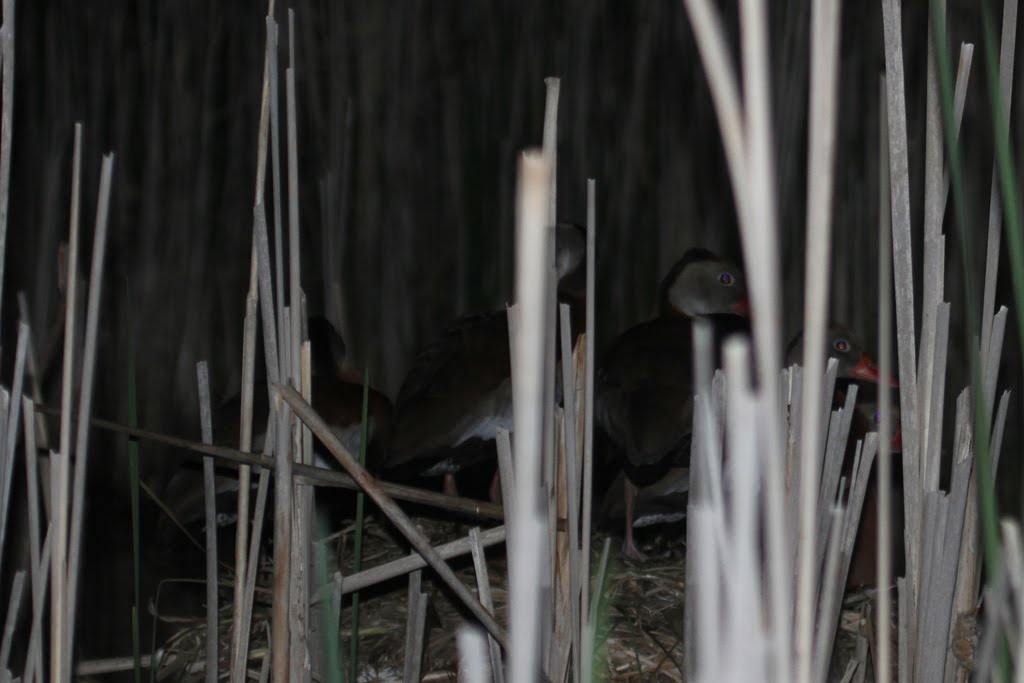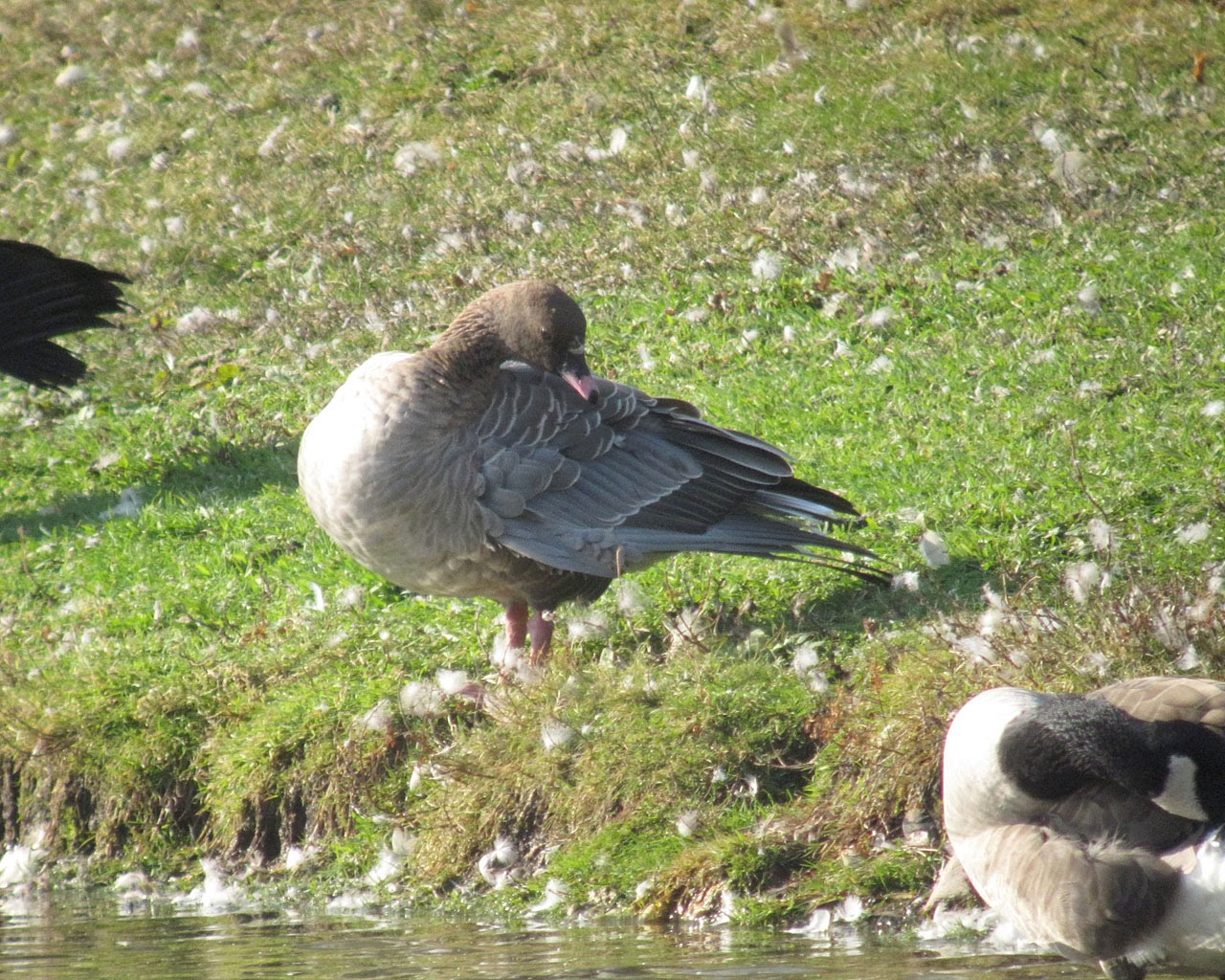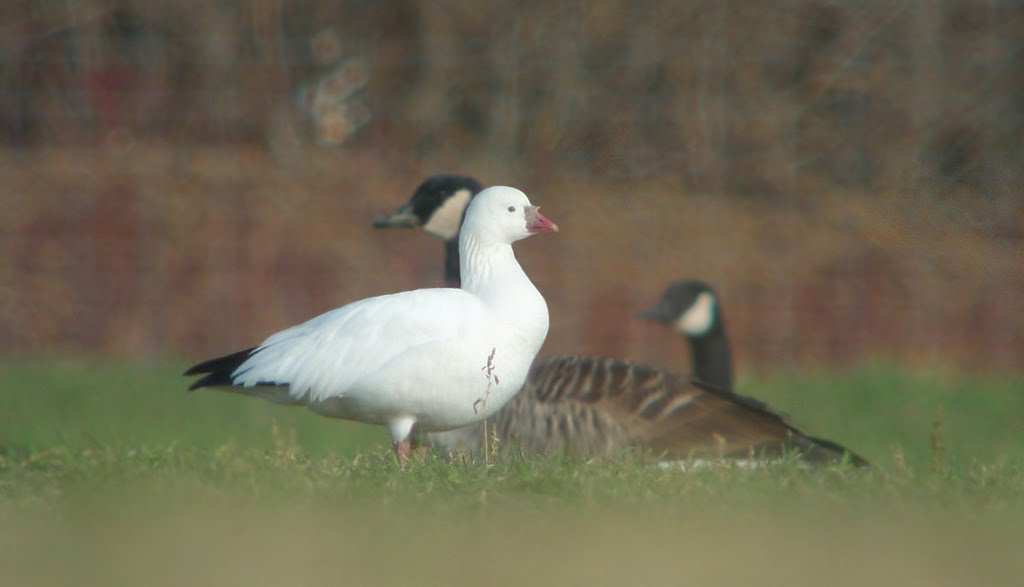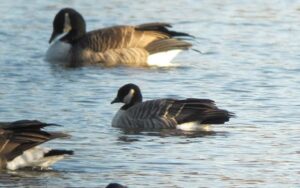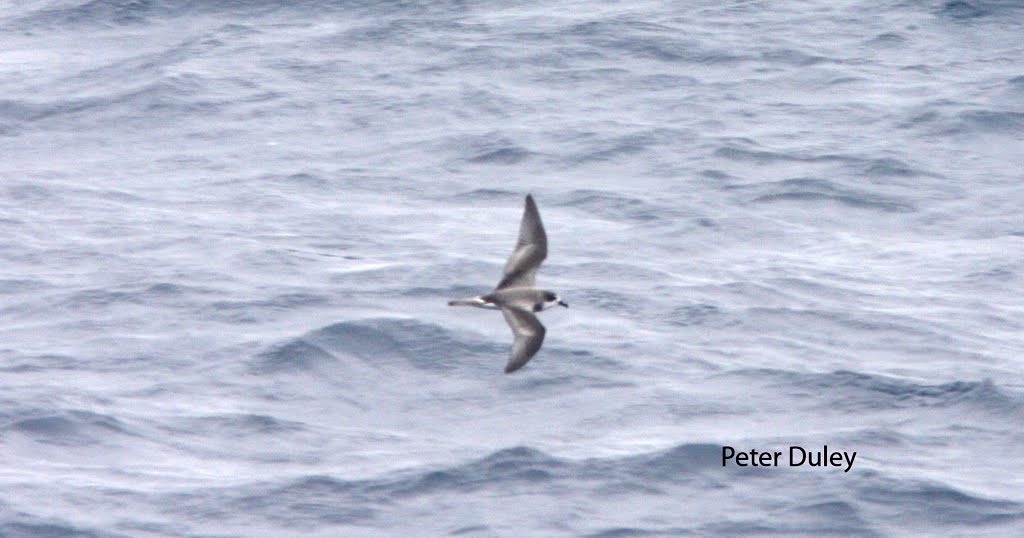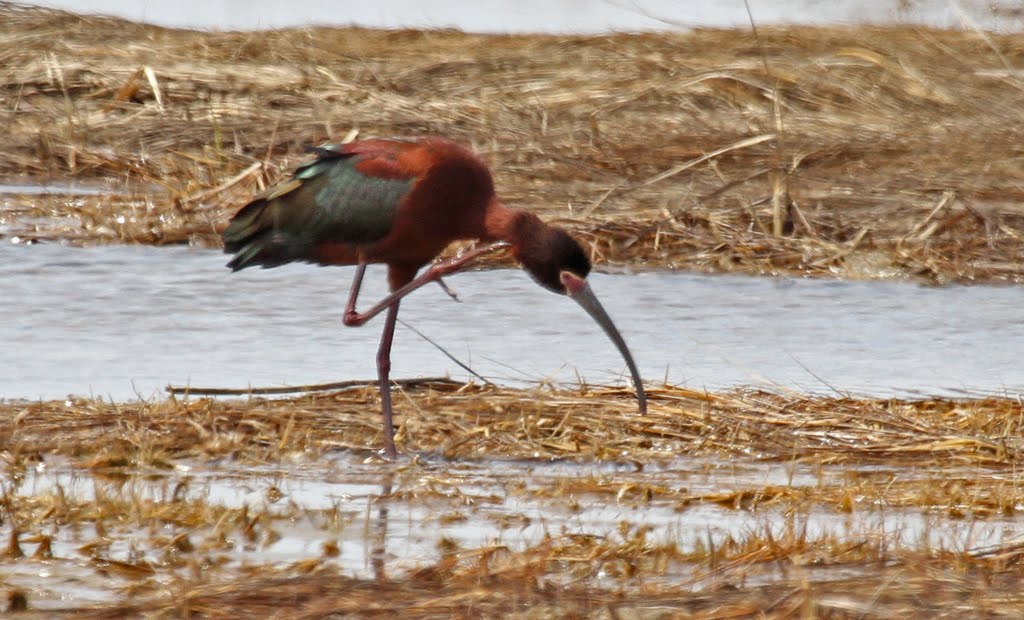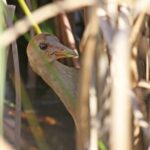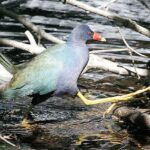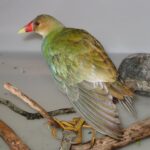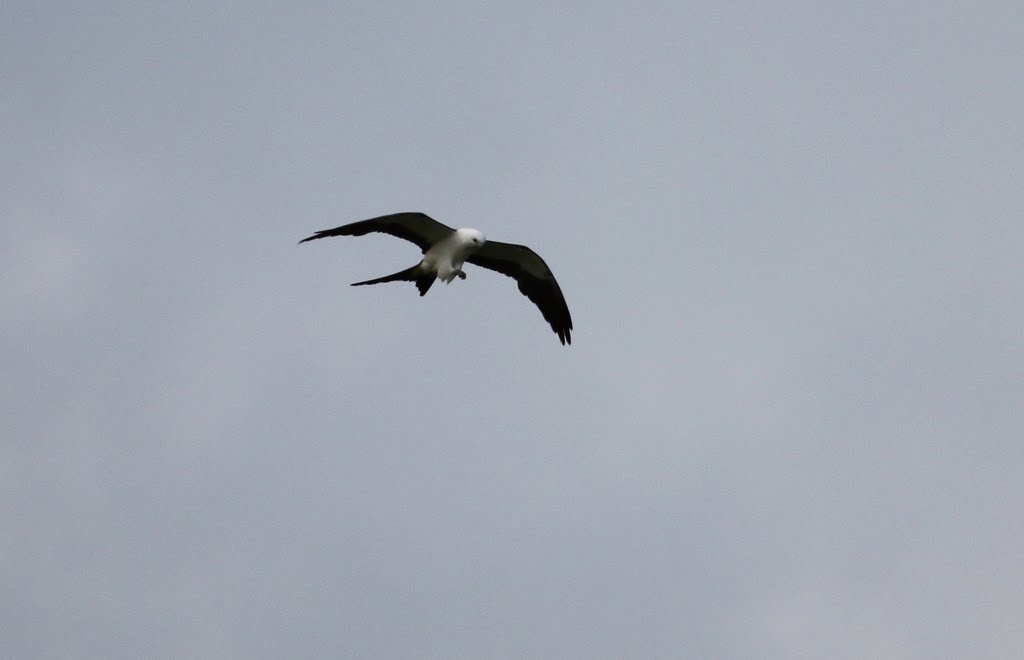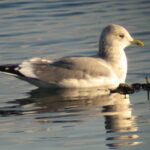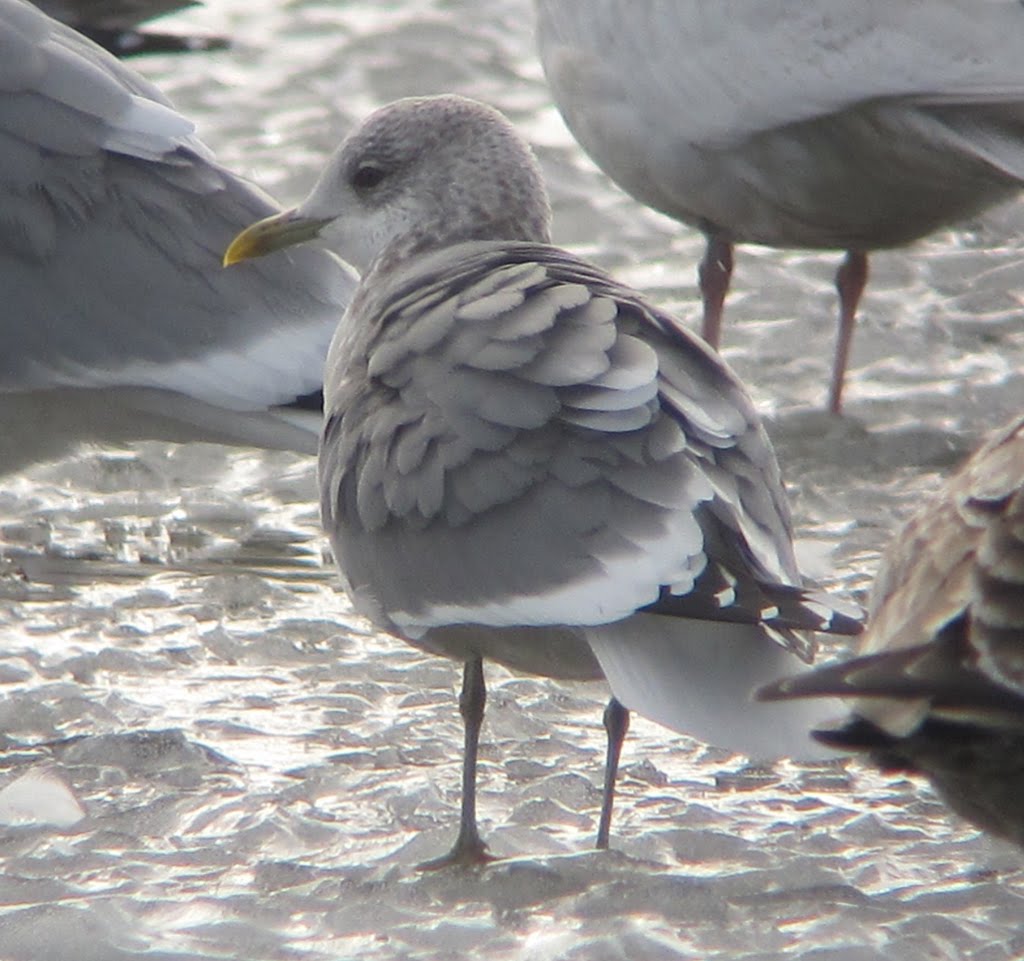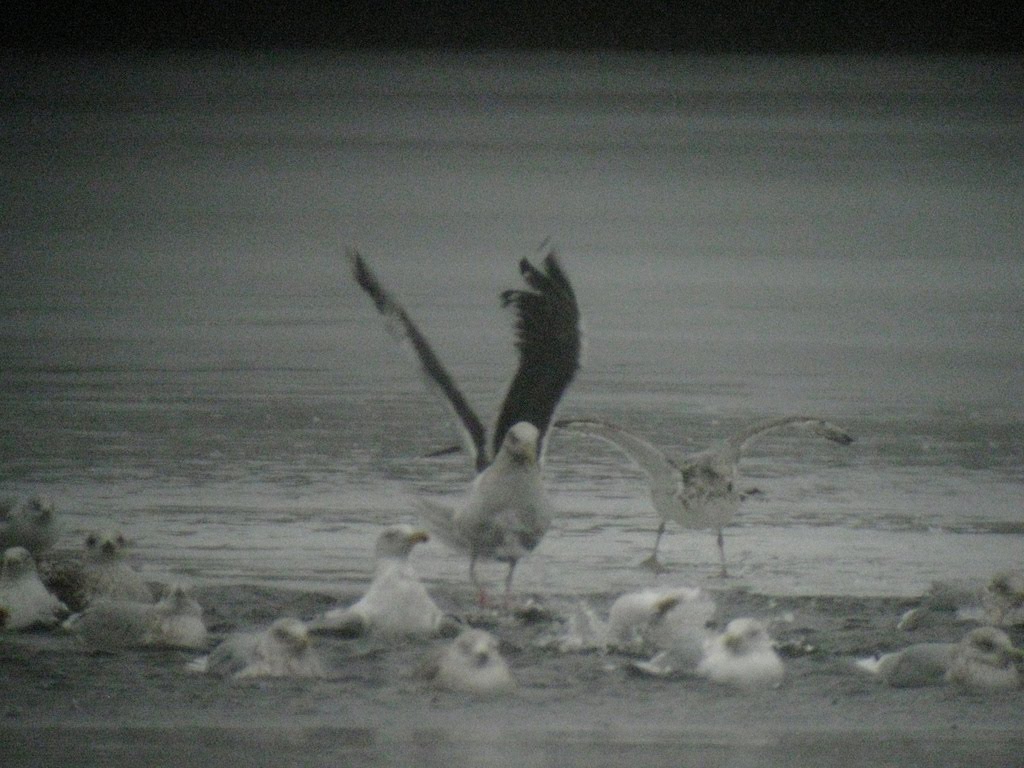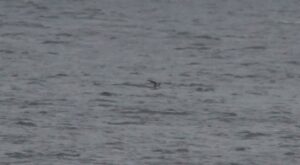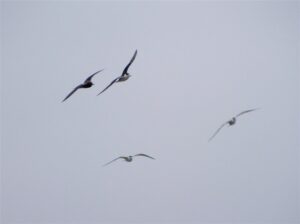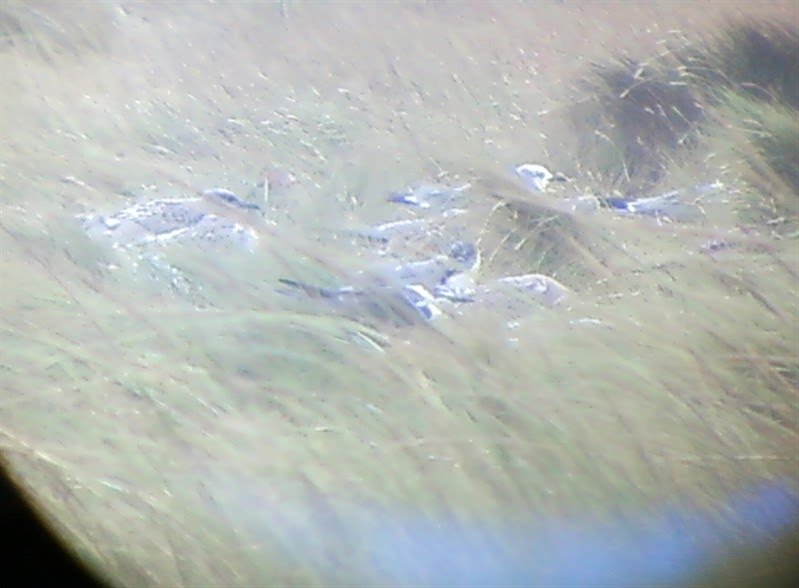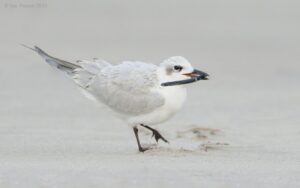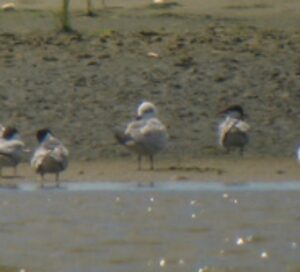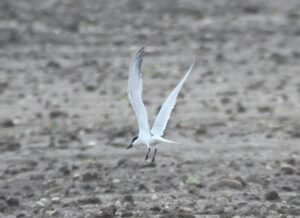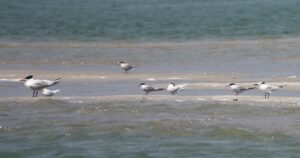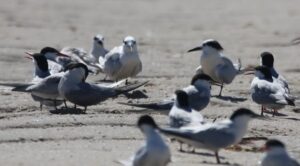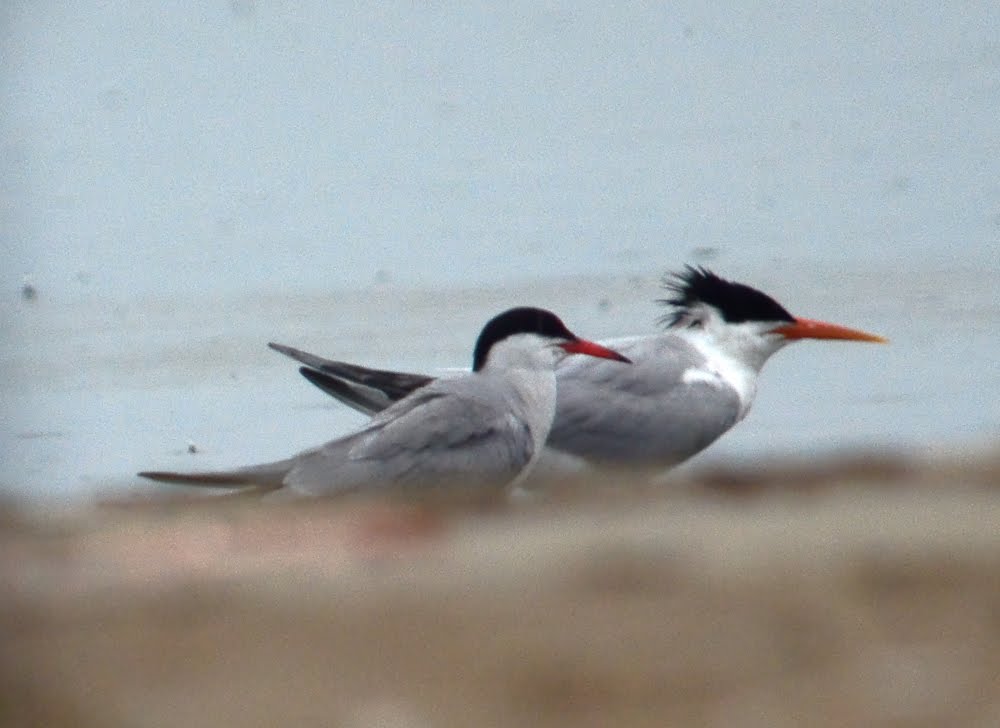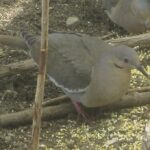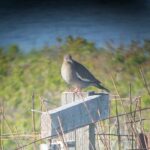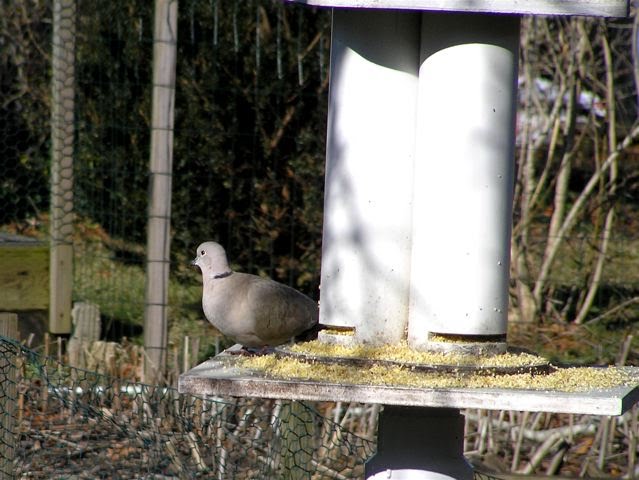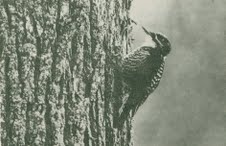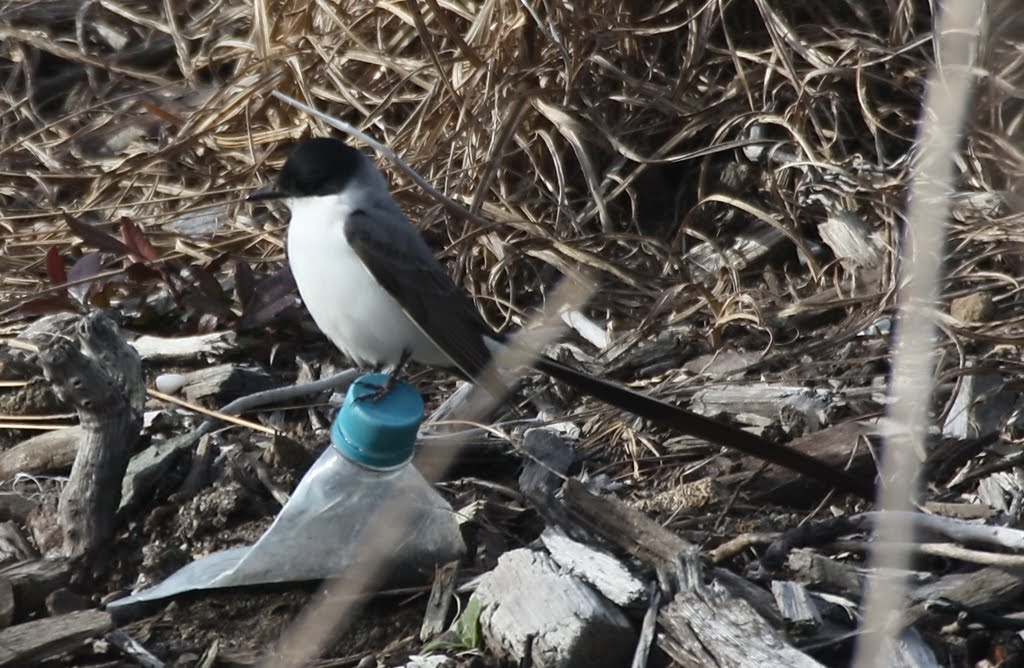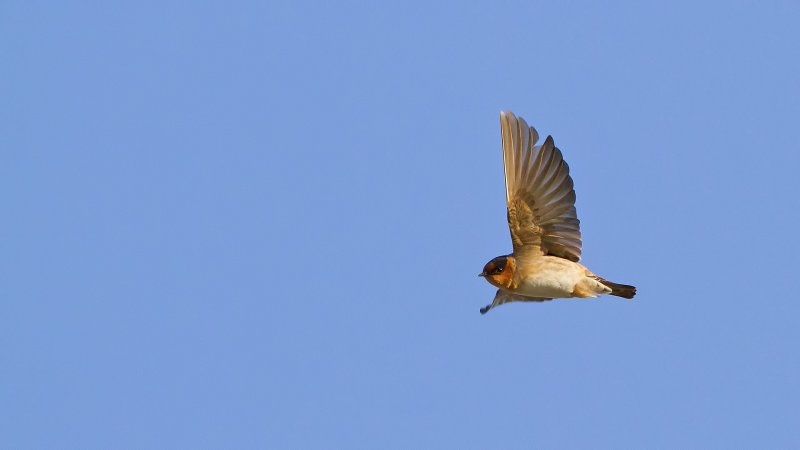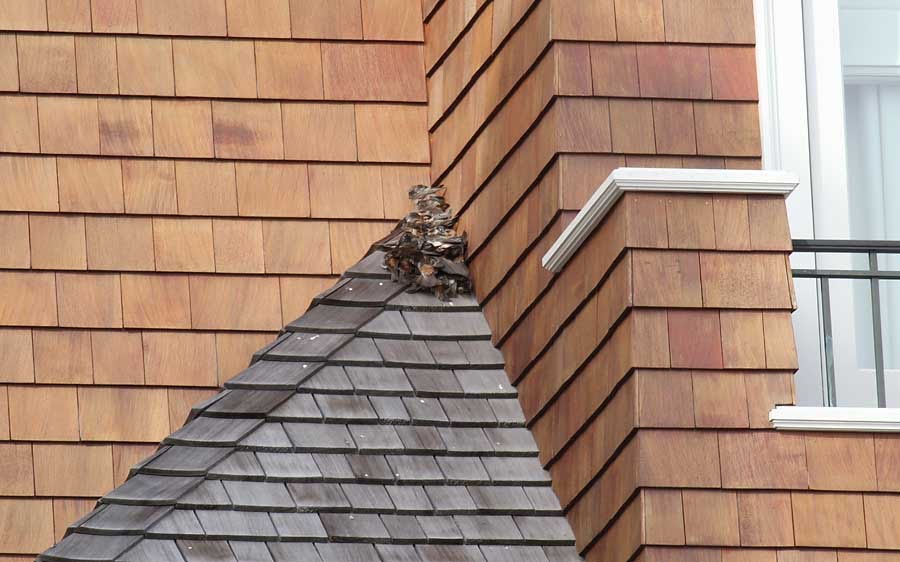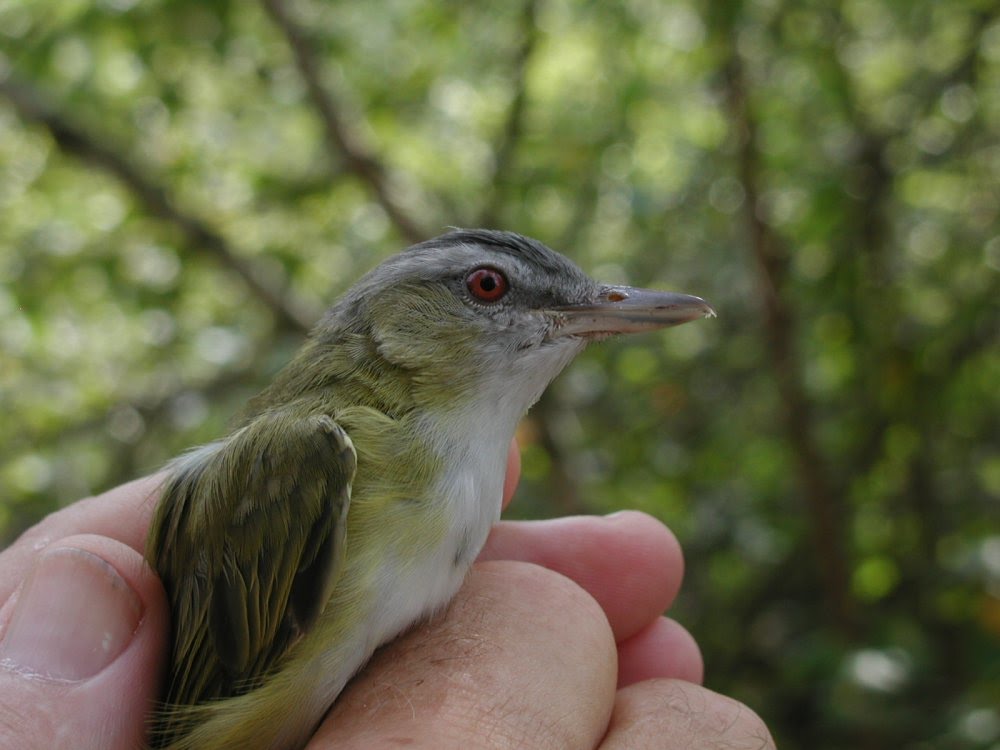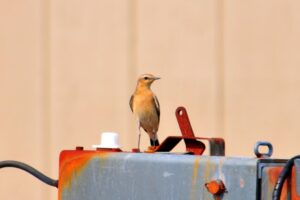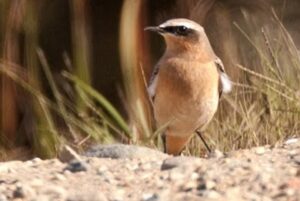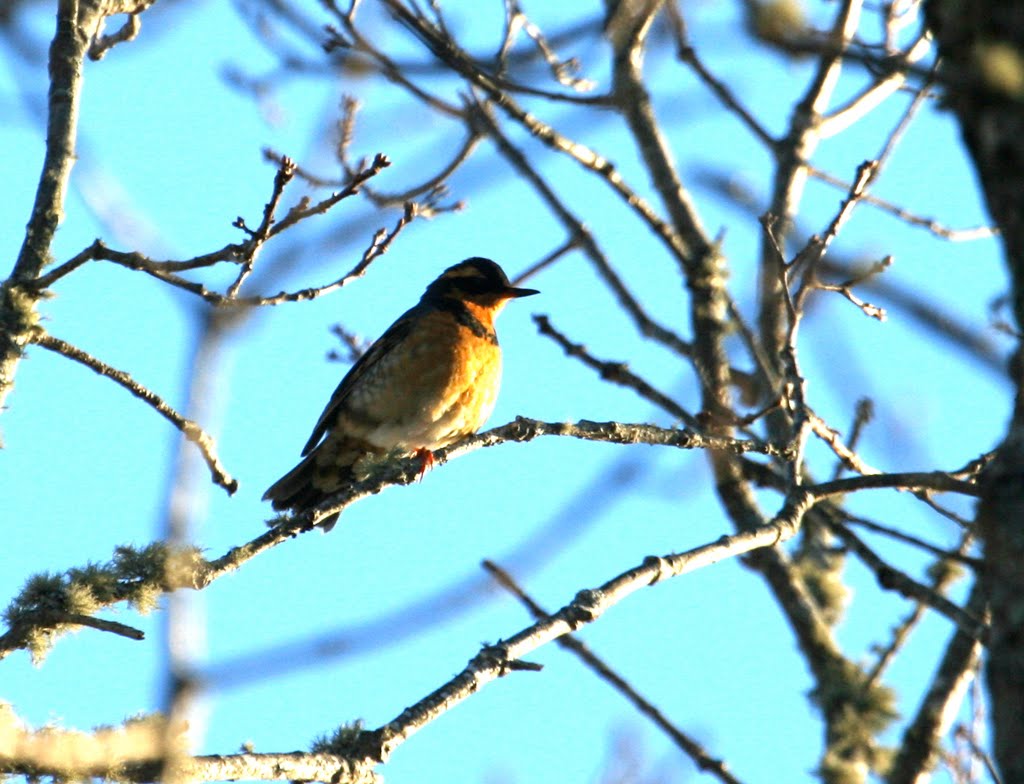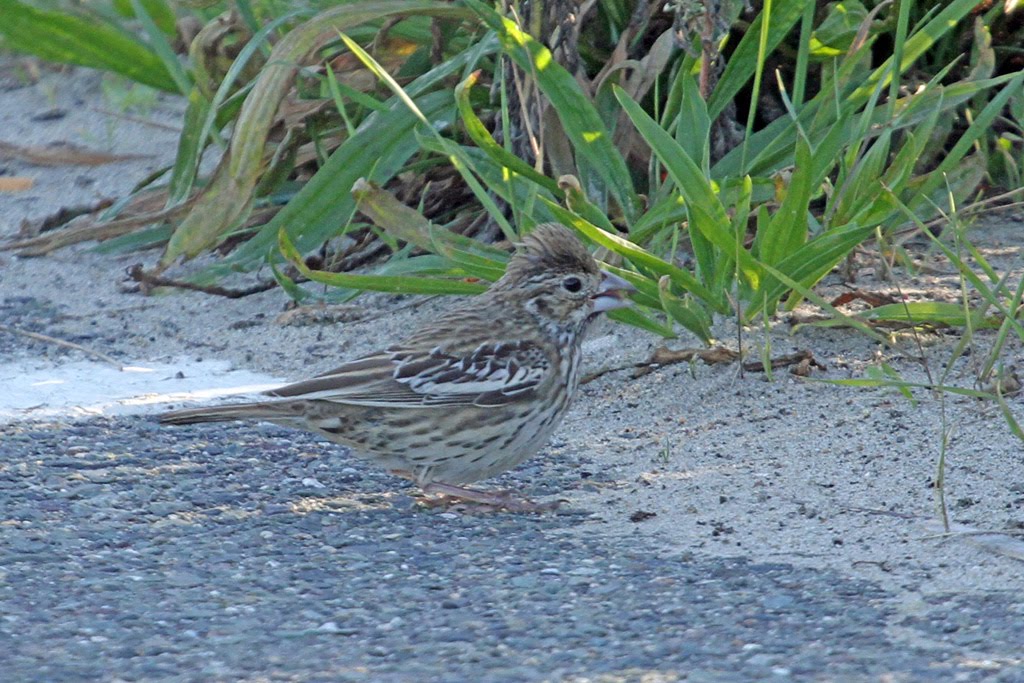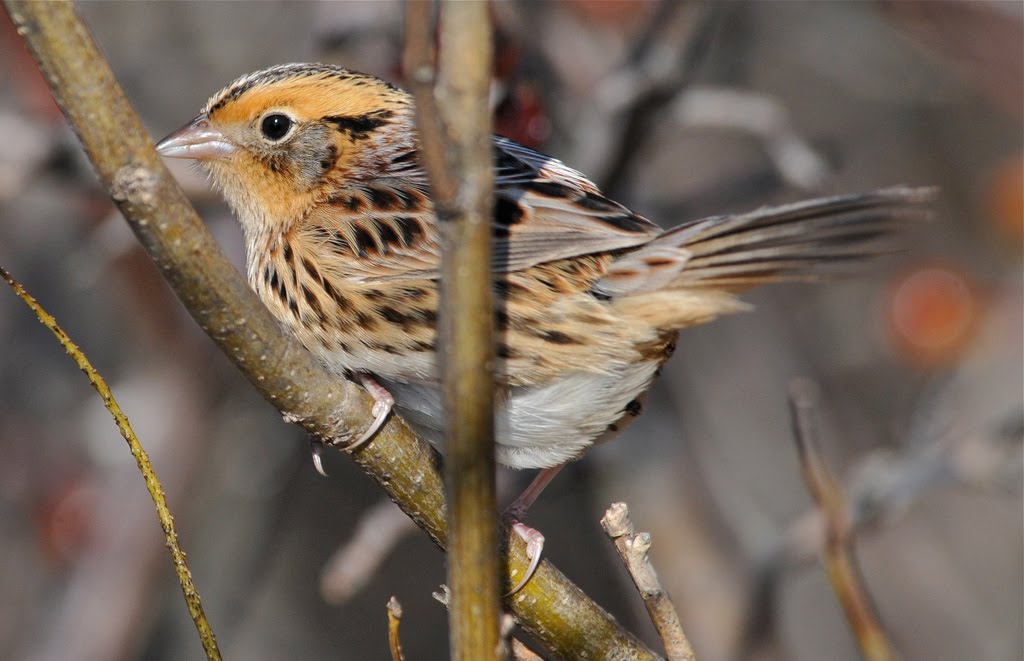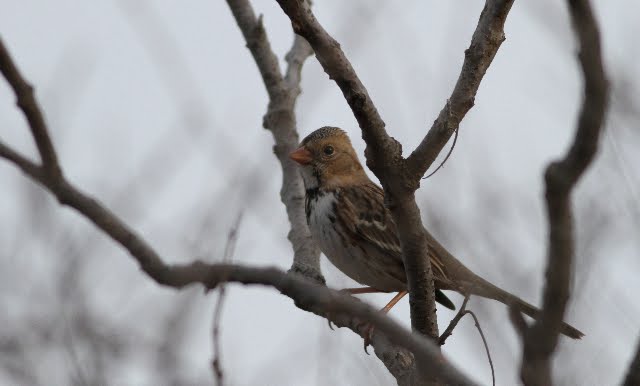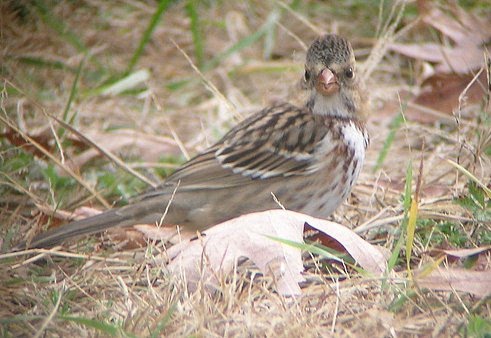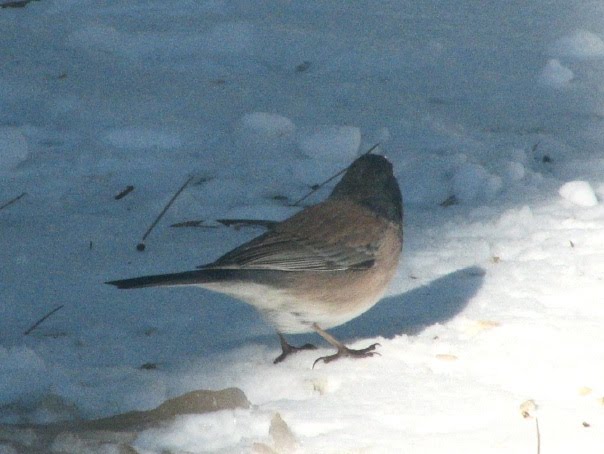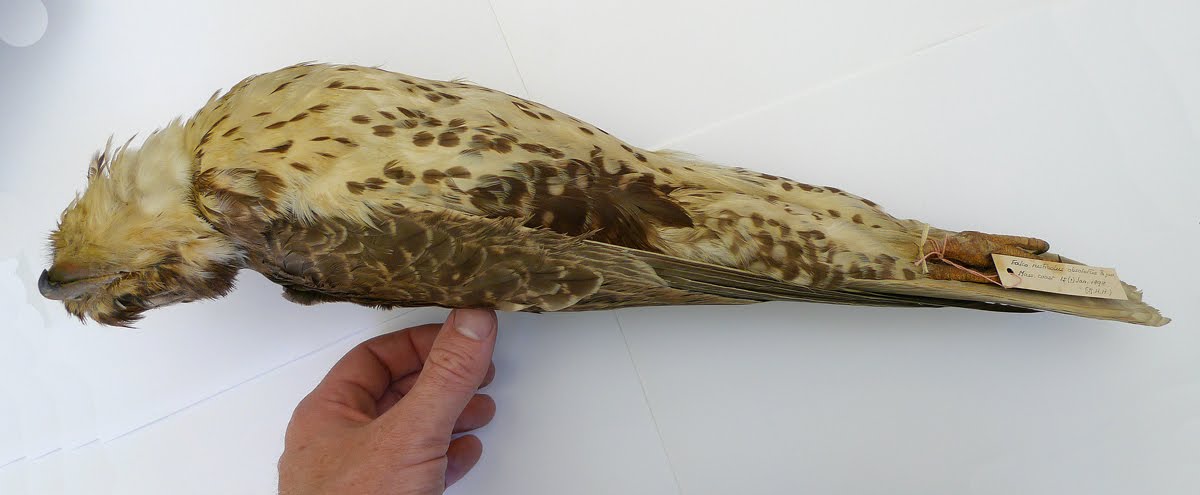SIXTEENTH ANNUAL REPORT OF THE
MASSACHUSETTS AVIAN RECORDS COMMITTEE
by Matthew P. Garvey and Marshall J. Iliff
originally published in Bird Observer
The sixteenth report of the Massachusetts Avian Records Committee (hereafter MARC or the committee) details the evaluation of 107 records involving 71 species or subspecies. Ninety-seven records were accepted, an acceptance rate of 90.7%. All accepted records in this report were accepted unanimously on the first round of voting unless noted otherwise.
Four new species have been added to the State List: Bermuda Petrel (Pterodroma cahow), Eurasian Hobby (Falco subbuteo), Yellow-green Vireo (Vireo flavoviridis) and Cassin’s Sparrow (Peucaea cassinii). The petrel is just one more reminder of how much we still need to learn about bird distribution in our pelagic waters, and how much value intrepid birders can provide by getting out there and documenting what you see. The hobby teaches the opposite but not necessarily conflicting lesson—don’t neglect your patch! This one-day wonder was spotted and identified by Ian Davies from his house, while he was enjoying a lunch break. The vireo and sparrow reflect a major theme running through this report, the prevalence of southwestern birds in Massachusetts from spring through fall of 2011. It may well be that some of these birds wandered away from their typical range in reaction to the extreme drought that affected the Midwest, Southwest, and northern Mexico from November 2010 through May 2012 (North American Drought Monitor 2012). While it is impossible to link specific records to those conditions, a clear diaspora is evident based on the unusually high number of records—especially in the Midwest and Northeast—of southwestern birds outside known areas of breeding (Iliff et al. 2011). Massachusetts was well represented in this diaspora, best attested to in this report by the 10 or more records of Ash-throated Flycatcher from fall 2011 (one of which is discussed below).
Another theme linking many of the birds in this report was Tropical Storm Irene, which deposited myriad Caribbean and southern Gulf Coast birds into the Bay State and produced a frenetic day of birding on August 28, 2012. Another suite of records are linked not by climactic event but by means of preservation; the MARC reviewed 46 skins of 19 species of review birds housed at the Harvard University Museum of Comparative Zoology, putting some more of the state’s rich ornithological history into the committee’s centralized database but barely putting a dent in the committee’s long backlog of unreviewed historic records.
As usual, some of the most instructive records in this report are ones the committee did not accept. Two records in particular put the committee at the very bleeding edge of bird identification, even despite superb documentation. One of these was a scene-stealing putative Yellow-legged Gull (Larus michahellis) that spent April 2011 in Hyannis, which the committee ultimately rejected after review of a vocal recording from April and photos of presumably the same bird at the same beach in fall revealed plumage characteristics (especially a streaky neck and head) more consistent with a Herring x Lesser Black-backed hybrid (Larus argentatus x Larus fuscus). Similarly, a putative Tropical Kingbird (Tyrannus melancholicus) was documented about as well as could be hoped for, with the glaring exception of voice recordings. Although some argued that structure was diagnostic for Tropical, the required majority of committee members ultimately could not get comfortable eliminating the similar Couch’s Kingbird, so the record will go down as a Tropical/Couch’s. In both cases, however, the bevy of evidence collected will hopefully prove instructive, not only now but to future generations of birders, highlighting the importance of gathering and archiving evidence even if it doesn’t get a particular record into the accepted column.
The list of species reviewed by the MARC (the “Review List”) is available at www.maavianrecords.com.
MARC depends on birders of all skill levels in the strong Massachusetts birding community to provide evidence needed to evaluate and, more importantly, archive the state’s rich ornithological record, and we are extremely grateful to all who provided the evidence used in this report. Individuals who have provided evidence, whether photographic (ph.), video (v.), or audio (au.), are noted in parenthesis in each account. The committee strongly encourages written submissions (signaled below with a “†”), even where photographs exist. The names of evidence providers are followed by the MARC record number. In addition, when known, we try to credit the discoverer either in the text or with an asterisk (*) if he or she has supplied evidence.
The species accounts below include specific geographic information for each record, including the location, town, and county (the latter is shown in italics). Species taxonomy and nomenclature follows the seventh edition of the AOU Check-list (AOU 1998) and supplements (e.g., Chesser et al. 2009, Chesser et al. 2010, Chesser et al. 2011). Each species is listed with its scientific name the first time it is mentioned in the text, but not thereafter. Subspecies nomenclature follows the Clements Checklist of Birds of the World taxonomy (version 6.6), available at http://www.birds.cornell.edu/clementschecklist.
The 2011 roster of MARC voting members was Marshall J. Iliff (chair), Mark Faherty, Trevor Lloyd-Evans, Blair Nikula, Wayne R. Petersen, James P. Smith, Scott Surner, Jeremiah R. Trimble and Richard R. Veit. In spring 2012, Smith’s term expired and he opted not to take on a second term. Ian Davies was elected to fill his vacancy. Jeremiah R. Trimble was also elected to serve his first term, after serving for the past year as a temporary replacement for Richard S. Heil, who retired before the completion of his term. Matt Garvey was appointed for another year as secretary, and Marshall J. Iliff was re-elected chair. We thank Smith for his service as a voting member. We also thank Erik Nielsen for considerable work on the MARC database over the past two years. Naeem Yusuff has officially been designated MARC Map-master, with many thanks for his help in strategizing for how best to represent our records with powerful and accurate graphical tools. Perhaps most importantly, we wish to thank Ryan Doherty, who joined the team in 2011 as a volunteer Web-master and has significantly revamped and improved the design of the MARC website. Blair Nikula, Jeremiah Trimble, and Scott Surner provided valuable editorial assistance on this article.
As introduced last year, we report statistics after the species name for each rare bird. The numbers in brackets show the number of MARC’s accepted records in this report, followed by the total number of MARC accepted records for that species, followed by our estimate of total known records, often supplemented with a plus sign (+) where we know there are additional records but are not sure how many. We do not count or use a plus sign for 2011 or 2012 records that are currently in review. Even where a subspecies is specified, the statistics given refer to the species unless noted otherwise. Species not on the Review List do not receive a count.
As you’ll see, the committee could keep itself busy just tracking down and reviewing all the known records that have not yet been reviewed. While that would be fun, we much prefer reviewing–and of course experiencing live–new records. So keep finding new birds and getting the word out–and please remember to send us your documentation!
ACCEPTED RECORDS
Black-bellied Whistling-Duck (Dendrocygna autumnalis) [1*,2,2]
The committee voted to treat the five adults found by Lee Maxley at Temple St. pond, Duxbury, Plymouth, on April 29, 2011 (†L. Maxey*; 2011-16) as the same roving flock of five identified by call, and later seen and audio recorded, at the Concord unit of Great Meadows NWR, Concord, Middlesex, on the evening of May 3 and at dawn the following morning (au. M. Garvey, †M.J. Iliff*, ph. J. Offermann, au. J. Trimble*; 2011-17). This was a good flock to test MARC’s new practice of voting on whether multiple records might pertain to the same individual birds, as there were 2011 records of Black-bellied Whistling Ducks in New Hampshire, New Jersey and New York too, all or almost of which likely related to the same birds (Mirick 2011). There was only one prior record of this species in Massachusetts, but with an exploding population in the southeast and this species’ tendency to prospect far and wide in the April to July period, more should be expected.
Pink-footed Goose (Anser brachyrhynchus) [2,4,4]
Massachusetts gained its third and fourth records, one a long-staying bird found by George Gove that split time amongst fields in Sudbury and Concord, Middlesex, from November 17 through December 26, 2010 (ph. E. Nielsen, ph. J. P. Smith, ph. J. Trimble; 2010-42) and the other a brief visitor to Turner’s Falls, Franklin, from October 26-28, 2011 (ph. C.&D. Fisher, ph. J.P. Smith*; 2011-45). Both were consistent with the state’s first two records: single adult birds that mingled with flocks of migrant or overwintering Canada Geese (Branta canadensis).
Ross’s Goose (Chen rossii) [1,9,9]
A long-lingering adult that spent December 11, 2010 through February 13, 2011, at Bartlett Farm, Nantucket (ph. J. Offermann, ph. J. Trimble*; 2010-44) was Massachusetts’s ninth record, and the first for Nantucket.
- Photos by James Smith
Cackling Goose (Branta hutchinsii) [3,13,18+]
Although the photos submitted to document the record were on print film and somewhat distant, on a second round vote all but one committee member endorsed the bird at Marshfield Athletic Field, off Mew St., Marshfield, Plymouth, March 11, 1996 (ph. †Russ Titus; 1996-26) as one of the state’s earlier records. The lone dissenter felt a runt Canada could not be ruled out. Turner’s Falls continues to produce the species, probably more regularly than anywhere else. James P. Smith found and digibinned different singles there November 5, 2010 (ph. J. P. Smith*; 2010-60) and November 19-24, 2010 (ph. J. P. Smith*; 2010-59). While this species was taken off the review list in 2011, records before that date are still reviewed.
Pacific Loon (Gavia pacifica) [1,16,16+]
A stunning, if distant, alternate-plumaged adult in Gloucester Harbor on June 7, 2011 served as a lovely reminder that Pacific Loons can show up along the Massachusetts coast any time of year (R. Heil* (ph); 2011-20).
Western/Clark’s Grebe (Aechmophorus occidentalis/clarkii) [1,7,7; count for Western Grebe]
A record submitted as Western Grebe consisted of a write-up and multiple distant (but about as well as could be hoped for given the setting) photos of an Aechmophorus grebe at Andrew’s Point, Rockport, Essex, on February 6-7, 2011 (ph. M. Goetschkes; †L. Farraresso*; ph. R. Stymeist; 2011-18). The record went three rounds and elicited much committee discussion on variation within Clark’s Grebe (Aechmophorus clarkii) and the prevalence of hybridization between Western and Clark’s. Bill color and face pattern (extent of darkness around the eye and on the lores) were especially tricky to assess given the bright lighting on the photographs. Ultimately, only three members felt the evidence supported a pure Western; most thought a hybrid with Clark’s could not be eliminated, and two thought a pure Clark’s was still in the mix as a possibility based on the photos submitted.
Bermuda Petrel (Pterodroma cahow) [1,1,1]
While doing research for the National Oceanic and Atmospheric Administration, Peter Duley photographed a Bermuda Petrel on June 28, 2009 (ph. †P. Duley* (ph); 2009-54) at 40 56.12’ N, 66 14.32’ W, about 313 km (194 miles, or 169 nautical miles) east-southeast of Nantucket. This record was published, with two photos, in North American Birds (Duley 2010), and the photos leave no doubt about the identification. In fact, the photos seem clear enough to establish the freshness of the bird’s plumage, indicating the bird was likely a juvenile bird, less than a year old.
The record was unusually thorny for the committee, however, since the bird was closer to Nova Scotia than Massachusetts, and thus not within the MARC’s jurisdiction as its bylaws were written at the time. However, the bird fell in a sliver of ocean that, though closer to Nova Scotia than any point in the U.S., is south of the Hague line, and thus within the territorial waters of the United States. Massachusetts was the closest state to the bird, so the committee did its patriotic duty and amended its bylaws to make sure this record would be reviewed at all. The bylaws were changed so that the “Adjacent Ocean” within MARC’s purview now include oceanic waters within U. S. territorial waters (i.e., south of the Hague line) and closer to Massachusetts than to any other state, within 200 nautical miles.
Although all prior U.S. and Canada records are from North Carolina, there is a possible sight record off Sable Island, Nova Scotia, and recent research with data loggers ensconced on Bermuda Petrels has produced datalogger tracks for the species that show adults dispersing regularly to waters off New England, Atlantic Canada, and even Ireland, apparently on feeding forays for their young (Duley 2010). Amazingly, it therefore appears that Bermuda Petrel is regular in New England waters and further records are to be anticipated. (In fact, some of the tracks currently published might be reviewed by the MARC to establish additional Massachusetts records, if that’s not too “Brave New World” for you.) The finding that Bermuda Petrel occurs off New England makes even more intriguing the accepted Bermuda/Black-capped Petrel record from the southwest corner of Stellwagen Bank, Barnstable, from April 22, 1991 (1991-01), which was documented with blurry photos that several committee members believed to portray a Bermuda Petrel (Garvey and Iliff 2011).
Little (Barolo) Shearwater (Puffinus (baroli) assimilis) [1,2,2]
Conducting seabird surveys for the National Oceanic and Atmospheric Administration, veteran seabirder Mike Force identified a Little “Barolo” Shearwater about 160 miles ESE of Nantucket on July 29, 2011 (†M. Force*; 2011-33). Although no photos were obtained, his detailed description–with careful attention to the face and upperwing pattern especially–was spot on to identify this bird as Puffinus assimilis baroli. Considered by many a species in its own right, those that split baroli as a monotypic species (e.g., Clements 2011) use the common name Barolo Shearwater. It is widely agreed by almost all authorities except the AOU (which MARC follows) that baroli is distinct from Little Shearwater Puffinus assimilis.
Just the sixth North American record of this taxonomically challenged taxon, this followed closely on the heels of the United States’s and Massachusetts’s first record in 2007 (Garvey and Iliff 2011). This record serves as yet another reminder that more time at sea is bound to bring payday for birders yearning to make significant contributions to our knowledge of bird distribution–or to get a lifer!
Wilson’s Storm-Petrel (Oceanites oceanicus)
Wilson’s Storm-Petrel is regular in oceanic and nearshore waters in Massachusetts, but almost never appears inland. The committee opted to formally review a specimen from Berkley, Bristol, August 16, 2007 (collected by M. Boewe (ph. Jeremiah Trimble); 2007-59). This location is about 24 miles north of the mouth of Buzzard’s Bay and about 24 miles west-southwest of Plymouth Bay, so a highly unusual locale for Wilson’s, which is far less likely than Leach’s Storm-Petrel (Oceanodroma leucorhoa) to appear inland.
White-faced Storm-Petrel (Pelagodroma marina) [22,28,37]
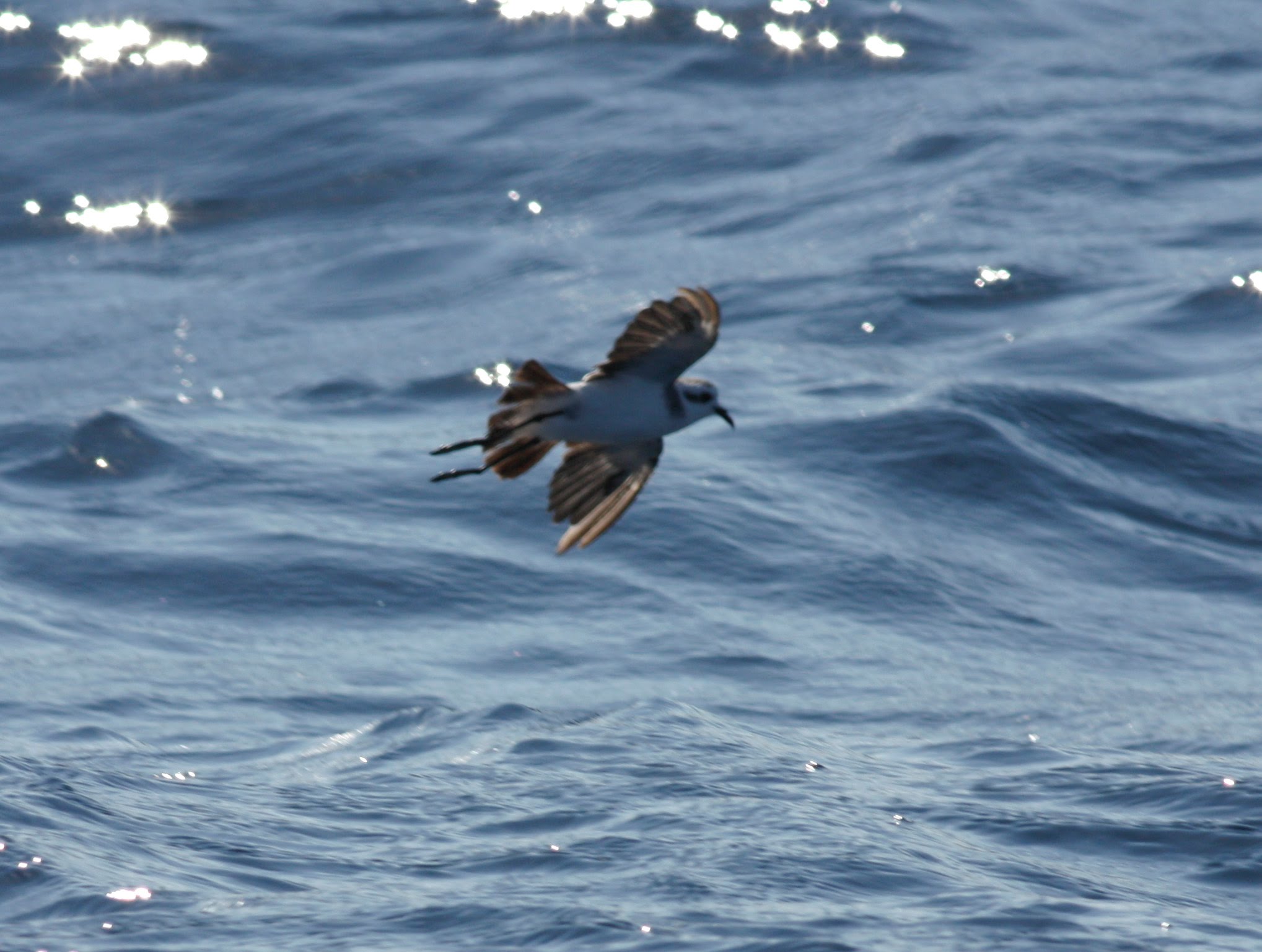
Photo by Benjamin Van Doren.
Exquisitely documented with photographs and a detailed submission matching photos to location over the water, a total of twenty-two White-faced Storm-Petrels delighted the fortunate participants of a late August, overnight Brookline Bird Club deepwater pelagic (ph. I. Davies*, ph. J. Forbes*, †M.J. Iliff*, ph. L. Seitz*, ph. S. Spangenberg*, ph. B. Van Doren*; 2010-41). All the birds were found along the edge of the Continental Shelf between Hydrographer and Dogbody Canyons in the afternoon of August 28, 2009 (five) or the morning of August 29, 2009 (seventeen). Of the twenty-two, six showed signs of heavy molt, indicating they were likely older than hatch-year birds, four appeared in fresh plumage likely indicating birds of the year, and the remaining twelve were not captured well enough to determine molt status (Howell 2012). This remarkable total exceeds the previous year’s September 3-4, 2009 record of six White-faced on a single trip, which was itself a record for the western Atlantic. Dogbody Canyon–which had not been surveyed on prior trips–was particularly rich in White-faced, with some thirteen birds seen over a two hour cruise there on the 29th.
White-tailed Tropicbird (Phaethon lepturus) [2,5,8] Tropicbirds are a prize quarry for storm watchers, and a full-streamered adult rewarded the folks stationed at Quabbin Park, Hampshire on August 28, 2011, who correctly predicted that Irene, a tropical storm as it passed through Massachusetts, would deposit vagrants on inland water bodies as she took a route up through central and western Massachusetts (†M. Iliff*, L. Therrien*; 2011-21). This, and another seen at Onota Lake, Berkshire, the same day (yet to be submitted), are the first live White-tailed Tropicbirds seen inland in the Northeast by birders. The other record was also related to an August storm, an adult female found dead at Kingsbury Beach, Eastham, Barnstable on August 22, 1991, just after Hurricane Bob had cleared the area (collected by E. Cudihy, ph. Jeremiah Trimble; 1991-09).
- Photo by J. Trimble
- Photo by S. Arena
Brown Booby (Sula leucogaster) [1,2,4]
A majority of the committee considered a subadult found by Mary Richmond at Corporation Beach, Dennis, Barnstable, August 16-24, 2011 (ph. S. Arena, ph. R. Barstow, ph. A. Curtis, ph. M. Keleher; 2011-34) to be the same bird that spent August 29-December 19, 2011 a bit further up the hand of the Cape at Herring Cove and MacMillan Wharf, Provincetown, Barnstable, (ph. D. Ely, ph. Thomas Dorazio, ph. M. Garvey, ph. M.J. Iliff, ph. B. Nikula*, ph. L. Seitz*, ph. B. Thompson, ph. J. Trimble*; 2011-35). Although it was seen feeding off Sandy Neck and Race Point, the bird spent much of its time at each spot standing or sitting on rock jetties, and it was sometimes hard to pick out amongst the thousand-plus Double-crested (Phalacrocorax auritus) and scores of Great Cormorants (Phalacrocorax carbo) hanging out on the jetty across from MacMillan Wharf in the fall. As most of those birds headed south, the booby hung tight, lasting much further into the cold season than most folks predicted this tropical visitor could have.
American White Pelican (Pelecanus erythrorhynchos) [2,11,15+]
One seen flying past Fort Hill, Barnstable on November 27, 2010 was described sufficiently by Meredith Nettles to rule out all but a pelican (†M. Nettles; 2010-47). While her description probably lacked sufficient details to conclusively rule out Old World white pelicans, her description of the bill as orange was highly suggestive of American, as was the date. The other record was collected at Cohasset, Norfolk, October 5, 1876, although the collector’s name is unknown (Jeremiah Trimble (ph); 1876-01).
Brown Pelican (Pelecanus occidentalis) [1,3,17]
A male was captured alive but ill at Nahant Beach, Nahant, Essex, November 11, 1988, and succumbed eleven days later (collected by C. Wasserman; ph. Jeremiah Trimble); 1988-05) (Veit and Petersen 1993).
Little Egret (Egretta garzetta) [1,6,7]
Although seen almost a month apart, a narrow majority of the committee voted to consider the adults found at Plum Island’s Parker River National Wildlife Refuge on July 9-10, 2011 (ph. W. Robel*, †F. & P. Vale*; 2011-14) and August 6, 2011 (ph. J. & A. Hoye*; 2011-15) as pertaining to the same individual. In July the bird was photographed feeding in the early morning with throngs of Snowy and Great Egrets at the pan across from lot 3, while in August it was photographed preening on a flat at Stage Island Pool. The fact that a month could pass between sightings at heavily birded Plum Island could suggest that there were in fact two birds, or could simply reflect the vastness of the Essex marshes and the number of egrets regularly traversing them. Some committee members further suggested that the bird at Scarborough Marsh, Maine, from June 29-30, 2011, might also have been the same individual. The 2011 Little Egret was Massachusetts’s first after a spurt of six records between 1989 and 1998.
White-faced Ibis (Plegadis chihi) [2,13,13+]
In recent years it has been clear that multiple White-faced Ibis have been using the Plum Island-Great Marsh ecosystem, and it has seemed likely that the same individuals have accounted for records in Ipswich and Manchester as well. Probably, these White-faced have been commuting with the Glossy Ibis that nest on Kettle Island, off Machester, a one-way flight of about 15 miles. White-faced Ibis have been seen in the Kettle Island colony in 2009 (Garvey and Iliff 2011) and again in May 2012. Although sorting out same-bird issues is generally impossible to do with precision, in 2011 it was much easier, since one adult White-faced Ibis on Plum Island, Essex, presumably the bird first seen there April 22 by Steve Haydock, was killed by a Peregrine Falcon (Falco peregrinus) on April 26, 2011 (v. M. Blust, ph. R. Schain; 2011-29). A group of Green Mountain College students led by Professor Michael Blust were watching and filming the ibis when the Peregrine swooped in and proceeded to strike and drown it. The entire struggle was caught on film, along with the raw reactions of the understandably horrified and amazed students. Sure enough, less than two weeks later, another adult White-faced Ibis was seen across Plum Island Sound at the Argilla Road Horse Farm in Ipswich, Essex, confirming the presence of at least two birds in the area. The latter bird was present at least May 8-16, 2011 (ph. M. Iliff*; 2011-30).
Yellow Rail (Coturnicops noveboracensis) [37,42,57+]
While current records and the species’ cryptic habits indicate that Yellow Rails still occur and are probably underdetected as fall migrants in Massachusetts, a review of the 37 (!!!) skins on file at the MCZ makes clear that they used to be much more common. A simple review of the locations where birds were taken between 1867 and 1936 reveals one of the major reasons why: appropriate wet grass and marsh habitat has disappeared since then at a dramatic clip. For example, Wayland, the source of five of these records, saw rapid development in its wet areas surrounding the lower Sudbury River in the mid-20th century (Walton 1984). And can you even imagine finding a Yellow Rail in urban Allston or Newton these days?
In addition to those on the following table, there are twelve specimens for which precise location and date are not currently known but are being investigated.
| Sex | Location | County | Date | Collector | Record No. |
| 2 M | “Cape Cod” | Barnstable | 10/14/1879 | unknown | 1879-01, -02 |
| 2 M | Weston | Middlesex | 9/22/1911 | unknown | 1911-01, -02 |
| F | Topsfield | Essex | 11/3/1893 | M.A. Frazar | 1893-01 |
| unknown | Allston | Suffolk | 10/14/1868 | A.L. Danielson | 1868-01 |
| M | Bedford | Middlesex | 10/11/1906 | G. A. Winn | 1906-01 |
| M | Lexington | Middlesex | 9/13/1876 | O. Bangs & E.A. Bangs | 1876-02 |
| M | Sudbury Meadows | Middlesex | 9/25/1901 | M. A. Frazar | 1901-01 |
| M | Sudbury | Middlesex | 9/26/1907 | unknown | 1907-01 |
| M | Wayland | Middlesex | 9/13/1898 | C. J. Payne Jr. | 1898-01 |
| M | Wayland | Middlesex | 9/19/1911 | unknown | 1911-03 |
| M, F | Wayland | Middlesex | 10/5/1920 | O. Bangs | 1920-01. -02 |
| M | Wayland | Middlesex | 9/29/1908 | unknown | 1908-01 |
| F | Dedham | Norfolk | 9/3/1911 | J. Healy | 1911-04 |
| F | Newton | Norfolk | 4/4/1867 | Charles J. Maynard | 1867-01 |
| F | Norwood | Norfolk | 9/12/1908 | F. B. McKechnie | 1908-02 |
| M, F | Marshfield | Plymouth | 10/3/1936 | J. L. Peters | 1936-01, -02 |
| F | Marshfield | Plymouth | 9/30/1936 | J. A. Hagar | 1936-03 |
| M | Plymouth | Plymouth | 10/10/1893 | unknown | 1893-01 |
| M | Scituate | Plymouth | 9/18/1908 | unknown | 1908-03 |
| M | Wareham | Plymouth | 9/19/1899 | O. Bangs | 1899-01 |
- R. Schain
- B. Sytmeist
- A. Cartoceti
Purple Gallinule (Porphyrio martinica) (4,5,51+)
An adult found by Steve Mirick that spent May 15-24, 2010 at High Street and Baker Pond in Lanesville, Gloucester, Essex (ph. R. Heil, ph. S. Mirick*, v. M. Keleher, ph. R. Stymeist; 2010-69) was possibly the same adult that spent May 25, 2010 at Great Pond, Eastham, Barnstable, (ph. S. Mumford; 2010-70), although there was no evidence linking the two. One hatch-year bird found distressed at Samoset Ave., Hull, Norfolk, December 27, 2010 (ph. A. Cartoceti; 2010-74) was in a transitional plumage with brilliant green tones on its back; its yellow-tipped red bill was sufficient to rule out similar Old World species. An immature found by a vagrant-searching crew of Ian Davies, Jeff Offerman and Ryan Schain at Cuttyhunk Island, Dukes, October 8, 2011 (ph. †R. Schain*; 2011-11) was nice proof that more time at this underbirded spot should pay dividends.
Swallow-tailed Kite (Elanoides forficatus) [4,9,9+]
2011 yielded myriad sightings of this elegant southern overshoot, which raised questions as to how many birds were involved. The MARC accepted as separate records the Swallow-tailed Kite seen in the afternoon at Oyster River, West Chatham, on May 29, 2011 (J. Kaar*; 2011-10) and the one found earlier the same day at Brievogel Ponds, East Falmouth. The East Falmouth bird, found by Bennet Porter while he was trying to walk his 8-month-old daughter to sleep, lingered in the area until May 31, where it consorted with Mississippi Kites and put on a show for photographers (ph. R. Barstow, ph. I. Davies, ph. E. Nielsen, ph. †B. Porter*; 2011-08). The committee treated as one record the birds seen independently, 1.5 miles and 16 minutes apart on July 11, 2011, first at Evergreen Cemetery, Chatham by Ryan Schain and then at the Morton Rd. bike trail, Chatham, Barnstable, by Fred Bouchard (ph. †R. Schain*, †F. Bouchard*; 2011-09), but did not vote to lump the July record with either of the May records. Although the MARC is generally generous in accepting written descriptions of this distinctive species, one committee member felt the description of the Oyster River bird, given only on the Cape Cod birders’ listserv, was too brief to warrant acceptance. The committee also accepted a specimen found dead in Holbrook, Norfolk, April 9, 1974 (collected by S. Fordham (ph. Jeremiah Trimble); 1974-03).
Mississippi Kite (Ictinia mississippiensis) (3,5,32+)
If the Swallow-tailed Kite numbers were impressive in 2011, the Mississippi Kites numbers were off the charts. The committee is still sorting through the reports and (all-too-few) submissions from 2011, but did accept three specimen records in the meantime: a juvenile female from North Easton, Bristol, September 8, 1982 (collected by M. H. McClellan (ph. Jeremiah Trimble); 1982-06), a female from Pembroke, Plymouth, May 29, 1993 (found dead by R. Fannighetti (ph. Jeremiah Trimble); 1993-28), and a male from Great Hill Rd., East Sandwich, Barnstable, in May 2000 (exact date and collector unknown (ph. Jeremiah Trimble); 2000-30).
Eurasian Hobby (Falco subbuteo) [1,1,1]
Why do some people seem to turn up an inordinate amount of megas? Sure luck plays a part, and hanging out in the right places. But preparation, persistence and keen senses are keys as well. On May 18, 2011, Ian Davies, just home from his first year in college, was having lunch at home when a bird perched a good distance away and piqued his interest. He immediately got on the bird, identified it as an adult Eurasian Hobby, captured a record shot and got the word out. How many of us would have even interrupted our lunch for a distant bird, much less considered Eurasian Hobby, at the time just the second record for the lower 48 and the first for the east coast? A lucky few birders were able to book down to Bartlett Pond, Manomet, Plymouth, and Jeremiah Trimble even got some dazzling photos before the bird disappeared, never to be seen again (ph. †I. Davies*, ph. J. Trimble; 2011-05). The only prior record from the Lower 48 hails from Seattle, WA, October 20, 2001. There is one record on mainland Newfoundland as well, from Cape Spear May 21, 2004, and one May 9-15, 1989, on an offshore vessel about 320 miles east of Newfoundland, showing that the western Atlantic does have a tight pattern of records in the May 9-21 window.
Gyrfalcon (Falco rusticolus) [1,5,60+]
A male collected at Stow, Middlesex, in 1881, unfortunately lacked an exact date or additional specifics (collected by C. I. Goodale (ph. Jeremiah Trimble); 1881-01).
Wilson’s Plover (Charadrius wilsonia) [1,9,34+]
While recent records seem to indicate this species is increasing as a spring and summer visitor to Massachusetts, it is worth noting the precedent in the historic record, such as the male collected at Truro, Barnstable, June 26, 1929 (collected by O. L. Austin Jr. (ph. Jeremiah Trimble); 1929-01).
Northern Lapwing (Vanellus vanellus) [1,2,2]
Massachusetts’s second record fortuitously flew into Jim Hully’s view as he was trying to photograph a Northern Harrier (Circus cyaneus) at the Pines Trail, Parker River National Wildlife Refuge, Essex, December 2, 2010, and he was able to capture stunning images of this one-day wonder (ph. †J. Hully*; 2010-61). Massachusetts’s only prior record is from Chilmark, Martha’s Vineyard, December 26-30, 1996. The 2010 lapwing was part of a small invasion, as that season also produced records in Connecticut, Maine, Prince Edward Island, Nova Scotia and an remarkable eight in Newfoundland, which also hosted from the Old World Jack Snipe (Lymnocryptes mimimus), Common Snipe (Gallinago gallinago), Chaffinch (Fringilla coelebs) and several Redwings (Turdus iliacus) that season, apparently related to a “Greenland Block” that produced severe cold weather in Ireland, the United Kingdom and elsewhere in northern Europe, and relatively warm weather in northeastern North America (Brinkley 2011).
Sharp-tailed Sandpiper (Calidris acuminata) [1,3,5]
A well-described juvenile found by Richard A. Forster at Newburyport Harbor, Newburyport, Essex, on November 3, 1973 (†W. Petersen; 1973-04) represents one of just five records for Massachusetts, just two of which have been juveniles.
“European” Bar-tailed Godwit (Limosa lapponica lapponica) [1,12,21]
A female collected approximately September 16, 1907 at Cape Cod, Barnstable (collected by C. R. Lamb (ph. Jeremiah Trimble); 1907-02) showed the white rump of the expected nominate subspecies. The date and locations are approximate because the bird was obtained at a market. Of Massachusetts’s twenty-one records, only four pertain to the darker Siberian form (Garvey and Iliff 2011).
Great Skua (Stercorarius skua) [1,2,35+]
Although skuas are notoriously difficult to identify, even sometimes after great looks, prolonged views and sparkling photographs of a bird spotted over Nantucket Shoals by Rick Heil on an August 28, 2010 Brookline Bird Club pelagic trip revealed the golden back spangling diagnostic for Great Skua (ph. J. Forbes, ph. L. Seitz, ph. S. Spangenberg; 2010-65).
South Polar Skua (Stercorarius maccormicki) [1,3,21+]
Some birders played the storm winds right and were even able to secure distant but diagnostic photos of a dark, even-colored South Polar Skua at First Encounter Beach, Eastham, Barnstable, on September 4, 2010 (†M.J. Iliff*, ph. R. Schain, ph. J. Trimble; 2010-80). This record came in the context of a great seabird flight in Cape Cod Bay following Hurricane Earl, which passed at least 100 miles east of Cape Cod.
- Photo by D. Bosler
- Photo by Phil Brown
Mew Gull (European) (Larus canus canus) [1,3,25+]
Committee members were able to closely examine a first-cycle bird collected at Chatham, Barnstable, February 8, 1908 (collected by N. A. Eldridge (ph. Jeremiah Trimble); 1908-04). Its tail and rump pattern, size and delicate bill placed the bird firmly as a member of the nominate subspecies; this was formerly the most expected subspecies, before the recent records from east Asia (see below).
Mew Gull (Kamchatka/heinei) (Larus canus kamschatkensis/heinei) [1,3,25+]
Four Mew Gull records along a seventeen mile stretch of the North Shore between November 2009 and March 2011 made for four of the most complicated votes that the MARC has yet attempted; although all four records had photos and the species identification was uncontroversial, the subspecies identification was very challenging on all four records. Making the votes even more difficult, committee members were asked to opine on which records might pertain to the same individual. The four records all pertained to single adult birds in Essex; one each at: East Gloucester Harbor and Brace Cove, November 26-December 7, 2009 (ph. P. Brown, ph. R Heil*; 2009-550; King’s Beach, Lynn/Swampscott, December 8, 2009 (ph. †D. Bosler, ph. M. Goetschkes; 2009-56); Niles Pond, East Gloucester, January 20-February 26, 2010 (ph. N. Bonomo*, ph. R.S. Heil, ph. J.P. Smith*; 2010-82); and King’s Beach, Lynn/Swampscott, February 24-March 5, 2011 (v. M. Garvey, ph. M. Iliff (ph), ph. E. Nielsen, ph. S. Sullivan, †J. Quigley*; 2011-32). Although Veit preferred to consider all records as pertaining to different individuals, and although Trimble felt that 2010-82 and 2011-32 looked different from the December 2009 bird, the majority of the committee (seven) ultimately considered all four records to pertain to the same returning bird. The fact that this was an unusual subspecies, and that Mew Gulls are much rarer now than they were in the 1980s and 1990s, certainly factored strongly in that decision.
Mew Gull has four subspecies globally and it has been proposed that these should be split as two or three species. Identification criteria can be straightforward at times, but adults can be quite difficult to identify, as evidenced by these records. The subspecies vary by size, bill shape and pattern, back color, winter head streaking pattern, and wingtip pattern. Key traits visible on some or all of the photos provided for the records above include: size close to Ring-billed Gull; rather substantial bill with a faint, zig-zagging subterminal ring that was pale gray; dark amber eye; and a medium dark back, darker than L. c. canus. The wingtip pattern showed a large mirror on p10 and p9, and importantly, a “string of pearls” pattern formed by white tongues between the gray mantle and black primary tips and broad, pale tips to the inner secondaries. This combination of traits, especially the wing pattern, should occur only in kamschatkensis or heinei. The central Russian L. c. heinei is poorly known and may intergrade to the west with L. c. canus and to the east with L. c. kamschatkensis. Although heinei has never been confirmed from North America, the committee felt uncomfortable assigning this bird to kamschatkensis, especially given the unknowns in the variability of L. c. heinei. Further comment on subspecific identification of this bird would be welcomed. The committee previously accepted a record of L. c. kamschatkensis (without qualification with respect to L. c. heinei, despite traits similar to these recent records) from Gloucester Harbor, Essex, January 2-3, 2007; some have suggested that the above records may also pertain to this same individual, in which case the bird would have been unrecorded in the winters of 2007-2008 and 2008-2009.
Slaty-backed Gull (Larus schistisagus) [2,4,4]
Another east Asian gull becoming more and more expected on the North American east coast is Slaty-backed. A second-cycle bird found by James Smith that spent February 20-27, 2009 at Turner’s Falls, Franklin (ph. J. P. Smith*, ph. T. Pirro; 2009-53) was identical in plumage and almost certainly the same bird seen about 50 miles down the Connecticut River Valley at New Windsor Landfill, Connecticut from February 9-13, 2009 (Kaplin and Hanisek 2009). Another Slaty-backed Gull, this one an adult, was a one-day wonder found by Marshall Iliff at Niles Pond, East Gloucester, Essex, on January 25, 2010, where it lingered just long enough for digiscoped record shots to be obtained through a light snowfall (ph. M. Iliff*; 2010-67).
- Photo by L. Therrien
- Photo by P. Champlain
Sooty Tern (Onychoprion fuscatus) [4,6,34+]
More so than any other bird, Sooty Tern is a hurricane bird in Massachusetts. Of the state’s many reports, all but seven have occurred in the context of hurricanes or tropical storms. As Tropical Storm Irene powered its way up the East Coast, eager birders began planning how and where to go birdwatching safely in the storm to best connect with potentially displaced seabirds. The track of the storm went right through western Massachusetts, and birders spread out statewide to survey Irene’s effects. Sooty Terns were seen in six places in Massachusetts on August 28, 2011, all by birders intentionally seeking storm birds: After the storm’s passage, an adult at Quabbin Park, Hampshire, flew along the northeast side of the dam and then circled up and drifted off to the south (ph. L. Therrien*, †M. Iliff*; 2011-43); one was seen at the mouth of the Bass River, Dennis (†S. Arena*; 2011-41); six were seen from Drift Rd., Westport, along the East Branch of Westport River, Bristol (ph. P. Champlin*; 2011-42); and, farthest east of the storm’s path, one adult joined a feeding flock of Black (Chlidonias niger) and Common Terns (Sterna hirundo) and Bonaparte’s (Chroicocephalus philadelphia) and Laughing Gulls (Leucopcephalus atricilla) off Beachmont, Revere (†M. Garvey*; 2011-40), establishing a new record for well-watched Suffolk.
Bridled Tern (Onychoprion anaethetus) [3,7,20]
Less prone to storm entrainment than Sooty Tern, when Bridled Terns are seen in hurricanes or tropical storms they tend to get pushed to beaches, and very rarely occur inland (as often happens with Sooties). Tropical Storm Irene produced multiple Bridled Terns in New York, Connecticut, and Rhode Island, and at least two in Massachusetts. On August 28, 2011, one was photographed at the Adamsville boat launch, Westport, near the mouth of the Westport River, Bristol (ph. P. Champlain*; 2011-44) and one was described at the Massachusetts Maritime Academy in upper Buzzard’s Bay, Bourne, Barnstable (†S. Arena*; 2011-46). Another Bridled Tern was reviewed and accepted by the committee, this one an unseasonal record of a female found moribund at the Twin Brooks Golf Course, Hyannisport, Barnstable, on the extraordinary date of January 16, 1995, following a southerly gale (collected by Ned Hardy (ph. Jeremiah Trimble); 1995-22).
- Photo by J. Fenton
- Photo by F. Grenon
- Photo by V. Laux
Gull-billed Tern (Gelochelidon nilotica) [3,4,44+]
2010 was an excellent year for Gull-billed Terns in the Bay State. An adult was at Bartlett Farm, Nantucket, June 10, 2010 (ph. V. Laux; 2010-79). A bird of unknown age was photographed distantly while it was roosting at the south cove of South Beach, Chatham, Barnstable, on August 27, 2010; it was also seen hawking insects over South Monomoy, Barnstable (ph. Francois Grenon*; 2010-76). A hatch-year bird was seen by many as it spent time roosting at Sandy Point, Plum Island and feeding across Plum Island Sound at Clark Pond, Ipswich, Essex from September 14-20, 2010 (ph. S. Sullivan*, ph. J. Fenton; 2010-75). Superb photos revealed dark internal marks on the tertials, which helped to establish the age as a hatch-year bird.
- Photos by Vernon Laux.
Sandwich Tern (Thalasseus sandvicensis) [4,8,8+]
The MARC accepted four records of these long-billed beach birds, all of which fit the expected pattern of adults seen with other terns in summer and early fall. One was photographed at Smith Point, Nantucket, July 8, 2008 (ph. V. Laux*; 2008-45), and two were photographed at Nantucket’s Great Point on September 6, 2010 (ph. V. Laux*; 2010-56). The other two records from Chatham, Barnstable, possibly pertain to the same bird, but the MARC had not yet implemented its procedure for formally voting on such matters when they were accepted: one adult was photographed at North Beach, Chatham, Barnstable, August 28, 2010 (ph. W. Petersen*; 2010-72) and another was seen flying past Cow Yard Rd., Chatham, Barnstable, across Chatham Harbor from North Beach, on September 2, 2010 (†J. Trimble*; 2010-71).
Elegant Tern (Thalasseus elegans) [1,2,2]
Eagle-eyed Ian Davies saw a photo posted to Massbird of a putative Royal Tern (Thalasseus maxima) taken at Sandy Pt., Plum Island July 23, 2011, and raised the idea that it was actually the much rarer Elegant Tern. The photos indeed left no doubt—the small size relative to neighboring Common Terns, thin dropping bill and shaggy crest established this adult as just Massachusetts’s second record and a new record for Essex (ph. S. Sullivan; 2011-31). Lesser Crested Tern (Thalasseus bengalensis) is unrecorded from North America but worth considering, especially since the Mediterranean/west African subspecies T. s. emigrate has a back color close to Elegant Tern. While eliminating Lesser Crested beyond any doubt may not be possible, especially since rump color was not seen, the thin bill with a gradual droop and apparent paler tip, very shaggy and drooping crest, and narrow white loral line seem more consistent with Elegant (Duivendijk 2010, Svensson, Mullarney and Zetterstrom 2009). This record and Massachusetts’s previous Elegant Tern–an adult at South Beach August 4-18, 2002–join records from Virginia (three), Florida, and the Texas coast as the only North American records in the Atlantic basin. Interestingly, there are a number of records from Europe as well, mostly involving summer birds appearing at colonies of Sandwich or Common Terns. This species is to be watched for in the future and all crested terns in Massachusetts should be identified with great care.
Black Skimmer (Rynchops niger)
Black Skimmers breed sparingly on Cape Cod and stray to coastal areas statewide, but inland records are almost unheard of. The committee formally reviewed an adult found moribund in a snowbank at Auburn, Worcester, March 14, 1993 (collected by Grocia (ph. J. Trimble; 1993-29). This is not only a remarkable locale, some 40 miles from the nearest salt water and 80 miles from the nearest Black Skimmer colony, but also a remarkable date, being more than a month earlier than any other Black Skimmer records for the state. This was during “The Storm of the Century”, a severe coastal storm that swept up the East Coast, so it seems clear that this bird was swept up in that storm and displaced northward. Veit and Petersen (1993) mention one other inland record from Springfield, Hampden, August 29, 1893, a bird collected after a hurricane.
Black Guillemot (Cepphus grylle)
Not a review species when found coastally, the committee opted to review an extraordinary inland record from August. A juvenile (apparently the New England breeding C. g. arcticus) found in Fitchburg, Worcester, was about 50 miles from the nearest salt water. Unfortunately, it was not accompanied by a date more specific than August 2002 (collected by S. deSantos (ph. Jeremiah Trimble); 2002-49). Massachusetts has two inland records: Quabbin Dike, Worcester, December 29, 1971 and one specimen from Fall River, Bristol, November 19, 1899 (Veit and Petersen 1993).
Boreal Owl (Aegolius funereus) [4,6,30+]
The committee accepted four specimens collected from a range of locations, all over a century ago: one in Newton, Middlesex, February 26, 1879 (collected by E. A. and O. Bangs (ph. Jeremiah Trimble); 1879-03); a male at Tyngsboro, Middlesex, March 11, 1885 (collected by W. H. Parham (ph. Jeremiah Trimble); 1885-03); one at New Salem, Franklin, January 1, 1903 (collected by P. Marshall (ph. Jeremiah Trimble); 1903-01); and a female at Hyde Park, Suffolk, November 26, 1905 (collected by Fred. Downey (ph. Jeremiah Trimble); 1905-01).
Great Gray Owl (Strix nebulosa) [5,6,52]
Five records from eastern Massachusetts over a hundred years ago were accepted: two birds taken in “eastern Massachusetts” during the winter of 1846-7 (collected by L. Agassiz (ph. Jeremiah Trimble); 1846-01, 1846-02 ); a male collected in Townsend, Middlesex, on February 14, 1890 (collected by J. P. Melzer (ph. Jeremiah Trimble); 1890-01); a male from Payson Park, Belmont, Middlesex, February 22, 1898 (collected by R. B. Malom and M. A. Frazar (ph. Jeremiah Trimble); 1898-02); and a female found in Dover, Norfolk, February 18, 1904 whose collector is unknown (Jeremiah Trimble (ph.); 1904-01).
Photo by Sheila Carroll.
Rufous Hummingbird (Selasphorus rufus) [2,18,18+]
One was seen, photographed and banded at Airport Hill, Worcester, where it lingered October 2-December 18, 2010 (ph. S. Carroll, †M. Lynch, †A. Hill (bander), ph. B. Humphrey; 2010-46). The photos were diagnostic for Rufous/Allen’s, and the bander’s notes provided just enough detail to eliminate Allen’s, with the identification hinging on the measurement of the fifth rectrix at 3.8 mm. Plumage, especially the central area of red gorget feathers, indicated an after-hatch-year female, which puts the expected range of the fifth rectrix at 2.7-4.0 mm for Rufous and only 2.0-2.8 for Allen’s (Pyle 1997). Easier to evaluate with the ability to study tail feathers in hand was one that succumbed at New England Wildflower Center, Marshfield, Plymouth, around November 17, 2003 (2003-44).
Black-chinned Hummingbird (Archilochus alexandri) [1,4,5]
With increased awareness, more late-season flowers, more feeders being kept out late, and overall better communication, records of western hummingbirds are on the rise. An immature male Black-chinned Hummingbird at Siasconset, Nantucket, October 31 to November 11, 2010 (ph. E. Ray; 2010-53) established Massachusetts’s fifth record of the species and second from Nantucket. Excellent close-up photos showed the narrow inner primaries unique to Archilochus and eliminating Calypte species like Anna’s (Calypte anna) and Costa’s (Calypte costae). The very similar Ruby-throated Hummingbird (Archilochus colubris) was eliminated by the broad, club-tipped outer primaries and a single purple gorget feather.
- Photo by Steve Grinley
- Photo by Dick Veit
- Photo by B. Fletcher
White-winged Dove (Zenaida asiatica) [5,20,29]
White-winged Doves continue to expand their range rapidly in the Southwest and southern Great Plains, and the resultant increase in vagrancy is apparent in Massachusetts. This report details five records, which generally fall into the two main periods of vagrancy: May-June and October-December. One was at Old Harbor Rd., Chatham, Barnstable, October 21, 2010 (ph. B. Fletcher; 2010-52); one visited a feeder on Desmond Ave., Watertown, Middlesex, Dec 4, 2010 to Jan 11, 2011 (ph. J. Beckwith*; 2010-63); one fed at the Birdwatcher’s General Store, Newburyport, Essex on May 5, 2011 (ph. S. Grinley*; 2011-28); one visited Tuckernuck Island, Nantucket, June 4-6, 2011 (ph. R. Veit*; 2011-26), and in the same area one fortuitously turned up in Edie Ray’s yard, Nantucket, May 9-12, 2011 (ph. E. Ray; 2011-25). Another White-winged Dove on Nantucket June 22, 2011 has not yet been reviewed by MARC, but raises the possibility there was a single bird wandering around Nantucket (and potentially Tuckernuck) during May and June.
Eurasian Collared-Dove (Streptopelia decaocto) [3,5,5]
With just two previous records from the state (from Essex May 28, 2005 and from Chatham, Barnstable County, October 30, 2006), it has been surprising how few Eurasian Collared-Doves have reached Massachusetts and the Northeast in general, especially considering their rapid spread across much of the rest of the country. Most interesting was news of up to four Eurasian Collared-Doves that visited the Fletcher yard, off Old Harbor Rd. in Chatham, Barnstable, on October 12, 2005, to January 12, 2006 (ph. B. Fletcher; 2005-60). This location is not far from the accepted Chatham record from October 2006 (Rines 2008). The total count of birds dwindled over that period, with some succumbing to predation by an Accipiter. Amazingly, the same yard hosted another Eurasian Collared-Dove May 12-22, 2011 (approximately) (ph. B. Fletcher*; 2011-24), and this general area is clearly one to watch for future Eurasian Collared-Doves! Another found on the Mass Audubon’s Birdathon at Steve Langer’s feeders on Eel Point Rd., Nantucket, May 14-15, 2011 (ph. S. Langer*, ph. E. Ray; 2011-23) provided the first for Nantucket. The Nantucket record engendered significant discussion with respect to how to conclusively eliminate African Collared-Dove (Streptopelia roseogrisea), the domesticated form of which is also known as Ringed Turtle-Dove. Songs and calls are most helpful, but the two species also differ in overall structure (Eurasian is larger, bulkier, and bigger-billed), tail pattern (Eurasian is dark on the outer webs of the outermost rectrix, while African is pale), and general coloration (Eurasian is more grayish, compared to rosy or vinaceous color on African). The Nantucket bird was accompanied by only a couple photos, the best of which showed a pale bird against dark grass and was substantially overexposed; only after correcting the exposure was the true color of this dove apparent, allowing the committee to accept it as the state’s fifth Eurasian Collared-Dove.
American Three-toed Woodpecker (Picoides dorsalis) [1,2,6]
A well-established historical record, with published photos in Bird Observer 3:2 (1975), was finally officially reviewed and accepted from Harvard, Middlesex, January 15-April 27, 1975 (ph. B. Sorrie; 1975-02). This record actually represents only the second record from Massachusetts endorsed by MARC (and the first confirmed by photo or specimen), although Veit and Petersen (1993) detail six records.
Ash-throated Flycatcher (Myiarchus cinerascens) [1,12,20+]
Fall 2011 was perhaps the best ever for Ash-throated Flycatchers on the East Coast, and Massachusetts had no fewer than ten records (possibly as many as thirteen). An article on eBird suggested that this “invasion” of Ash-throateds may have been due, at least in part, to the drought in the Southwestern U.S. Although more will be reviewed in 2012, just one well-documented record from this event has been accepted thus far. Active Boston birder Paul Peterson found and identified a worn hatch-year bird at the Winthrop Greenway, Winthrop, Suffolk, October 11-12, 2011 (v. M. Garvey, †P. Peterson*, ph. R. Schain; 2011-27). Detailed notes, plus photos, videos, and audio recordings of the soft “pwip” notes, established the identity of this Suffolk first.
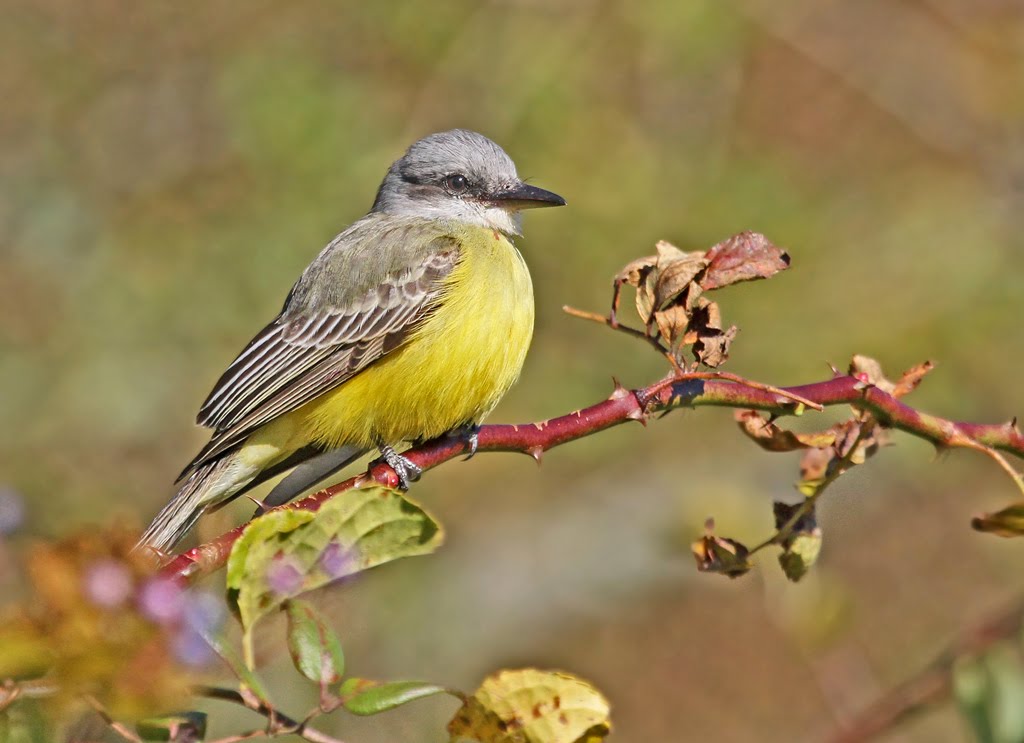

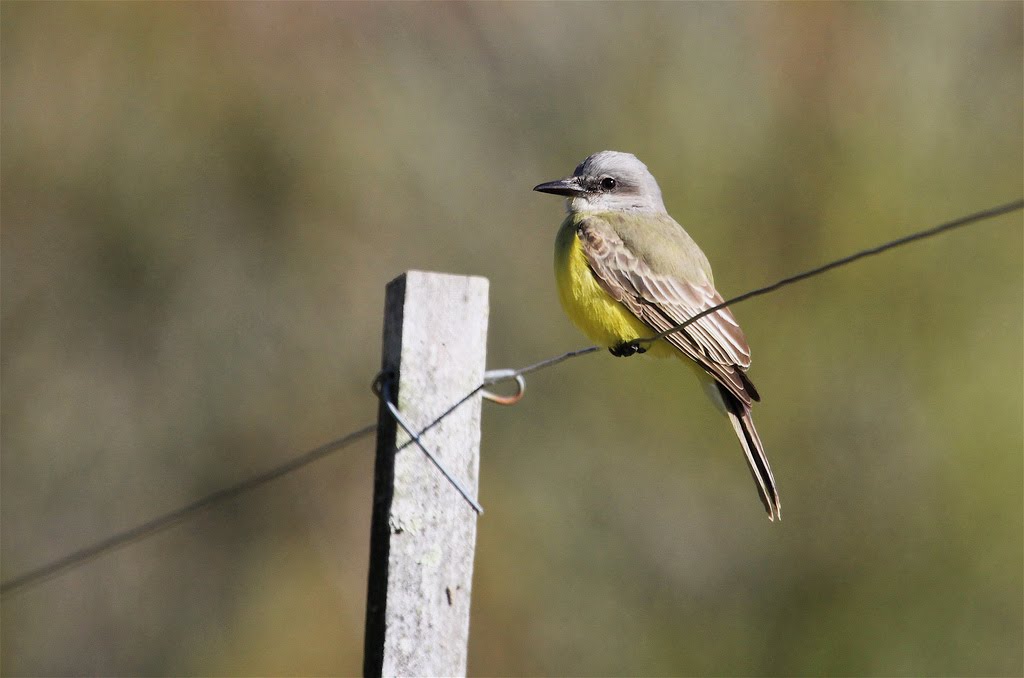
Photos by Ryan Schain.
Tropical/Couch’s Kingbird (Tyrannus melancholicus/couchii)
[1,3,3; one accepted as Tropical, one as Tropical/Couch’s, one as Couch’s]
A yellow-bellied kingbird found by Bennet Porter at Peterson’s Farm, Falmouth, Barnstable, October 30 to November 2, 2010, was exceptionally documented, well enough to age as a hatch-year bird, but ultimately not enough for the committee to get comfortable on an species-level identification (†G. Hirth, †M.J. Iliff, ph. M. Keleher, ph. J. Offerman, ph. †B. Porter*, ph. R. Schain; 2010-45). The two species are best separated by voice, and one of the lucky couple of people who heard it vocalize described a “brrrt” call, longer than a single note, that would be consistent with Tropical. (Many attempted to hear and record its voice without success.) Most members did not feel that this description of a single call by a single person was enough to establish the species identification. Identifying the two species visually remains extremely difficult, with bill length and wing formula being perhaps the most promising options. The relatively even, narrow, long bill was felt by some members to be on the long side for Tropical, and well beyond Couch’s. The wing formula was also supportive, with the folded wing showing 8 exposed primaries, with p9 and p10 below the longer eighth primary; on Couch’s, the outer three primaries are about the same length and should fall under the longest seventh primary (Pyle 1997), but the reliability of this as a field character is debatable. Arguably the most compelling evidence, Iliff measured from a photo the wing chord and bill length and compared those ratios using a published table (Pyle 1997); the wing:bill ratio of the Falmouth bird was .1607, beyond the values for Couch’s (0.128 to 0.147) and a good match with Tropical (0.143 to 0.183). A similar bill length:bill width ratio gave 2.125 for the Falmouth bird, which is below the value of 2.2 cited for Couch’s and matches the “below 2.2” ratio cited for Tropical (Phillips 1994). The third and final voting round included a review of an impressive collection of Tropical and Couch’s skins at the Harvard Museum of Comparative Zoology. Six voters felt the sum total of the evidence was just barely sufficient to support an identification of Tropical, but three members were uncomfortable given the difficulties of this identification. Specifically, they noted that the literature on wing and bill measurements (used for the ratios calculated by Iliff) were not clear as to whether they applied to adults only, or to hatch-year birds as well (Pyle 1997). The record was accepted as Tropical/Couch’s, which is how Bennet Porter originally submitted it.
Fork-tailed Flycatcher (Tyrannus savana) [1,6,17+]
Vern Laux got a call about an unusual, long-tailed bird at the Nantucket Dump and dashed out there to find an adult Fork-tailed Flycatcher on the exceptionally late date of November 30, 2010 (ph. V. Laux; 2010-68). Despite much searching, the bird was not seen after Vern’s spectacular photo shoot that afternoon.
Cave Swallow (Petrochelidon fulva) [3,17,17+]
Although this species was taken off the review list in 2011, records before that date are still reviewed, along with unseasonable records. Falling into the latter camp was a well-described bird seen by Peter Trimble in Hyannis Harbor May 15, 2010 (†P. Trimble*; 2010-73), only the second spring record in Massachusetts. Interestingly, the only other spring record was a bird seen 2-3 days earlier across the sound at Nantucket (Garvey and Iliff 2011). The fall invasion of 2010 was what finally convinced the committee to delist this almost-annual fall visitor, with groups of 3 at Salisbury State Reservation, Essex, October 30-31, 2010 (ph. P. Brown, ph. E. Nielsen, ph. S. Sullivan*; 2010-48), 17 at Pleasure Bay, South Boston, Suffolk, November 24, 2010 (ph. I. Davies, †S. Williams*; 2010-49) and 40+ from Chatham Light to Morris Island, Chatham, Barnstable, November 25-27, 2010 (ph. B. Nikula*, ph. J. Trimble*; 2010-50). A number of the Chatham birds succumbed and were found at an apparent roost under a staircase; these birds will be prepared at the MCZ to provide the first state specimens. All fall 2010 records were consistent with the southwestern subspecies P. f. peledoma. After delisting, of course, no Cave Swallows were reported in the fall of 2011, probably reflective of the fickle conditions required to bring mass numbers to the Mass. coast—northwest winds preceded by strong southerlies.
Yellow-green Vireo (Vireo flavoviridis) [1,1,1]
Not on most folks’ short list of the next new species for Massachusetts, an adult Yellow-green Vireo captured in the nets at the Parker River N.W.R. banding station on Plum Island was a shocker September 4, 2011 (ph. B. Flemer; 2011-39). The bird was still molting its outer primaries, so it may have been molting on the island for some time before being captured in the nets. Regardless, it was not relocated and joins a Sep/Oct 1992 record from Bermuda [A. Dobson pers. comm.] as the most outlandish occurrence of this long-distance migrant. The species breeds rarely in southernmost Texas, strays regularly to the central and southern California coast in fall, and occasionally to Southeast Arizona and New Mexico in summer and the Gulf Coast in spring and fall; it is accidental in south Florida, mostly in fall. Its occurrence in Massachusetts may have been related to the severe drought affecting the Midwest, Southwest and northern Mexico from November 2010 through May 2012, but unlike with Cassin’s Sparrow and Ash-throated Flycatchers, there was no clear diaspora of Yellow-green Vireos during this period (Iliff et al. 2011).
- Photo by M. Curran
- Photo by T. Griswold
Northern Wheatear (Oenanthe oenanthe) [1,8,8+]
The vast majority of Northern Wheatears in Massachusetts occur in September, with early birds reaching the state in late August and later ones being found in October. Both of the 2011 records fell right in the peak period, with one discovered and photographed by a visiting Irish birder at Hull, Plymouth, September 14-15, 2011 (ph. M. Curran*; 2011-12) and the other at vagrant-rich Nantucket, where it was much-enjoyed along fields and driveways on Polpis Rd. September 19, 2011 (ph. T. Griswold, ph. V. Laux; 2011-13).
Mountain Bluebird (Sialia currucoides) [2,7,7]
One of the more interesting specimens reviewed was a Mountain Bluebird that landed on a boat 70 miles south-southeast of Nantucket on April 28, 1980, where it eventually died (collected by J. Cherry (ph. Jeremiah Trimble); 1980-04). Its plumage indicated a male in first prenuptial molt. An immature male in a private community in South Dartmouth, Bristol, December 18-19, 2010 (ph. M. Boucher; 2010-66), was a nice find on a Christmas Count and a first county record.
Townsend’s Solitaire (Myadestes townsendi) [2,13,13+]
One found by Tom Pirro at the Chapel St./Carter St. intersection, Gardner, Worcester, December 23-24, 2010 (ph. †M. Lynch; 2010-43) was consistent with the majority of Massachusetts records, which occur in late fall or early winter.
Varied Thrush (Ixoreus naevius) [4,9,9+]
One described from a feeder on Highland Ave., Russell, Hampden, December 16, 2010 (†P. Belanger*; 2010-64); although the observer was not an experienced birder, she provided a nicely detailed description that convinced the entire committee on the second round. One was documented at a private residence at Lake Wequaquet, Centreville, Barnstable, February 5-19, 2011 (ph. A. Curtis, ph. D. Graf*, ph. M. Iliff, ph. P. Trimble; 2011-37). The specimen review verified two additional records. One male was found dead on the deck at Charles Crumm’s residence, West Tisbury, Martha’s Vineyard, Dukes, November 17, 1992 (collected by Charles Crumm (ph. Jeremiah Trimble); 1992-12). One found dead at Heathsbridge Rd., Concord, Middlesex, December 31, 1987 (collected by unknown (ph. Jeremiah Trimble); 1987-05) was identified as Ixoreus naevius meruloides, the subspecies that breeds from “N Alaska and nw Canada to nw US” and “winters to w-central US” (Clements 2011). This northernmost and easternmost subspecies is the most expected to occur as a vagrant to the East, since the nominate form is restricted to the Pacific coast (from Alaska to nw California) and I. n. carlottae is a Queen Charlotte Island endemic.
Connecticut Warbler (Oporornis agilis)
Regular in the fall, Connecticut Warbler is almost unheard of in spring in Massachusetts, since the species’ migration route passes almost entirely west of the Appalachians. One at the Nahant Thicket during Birdathon on May 14, 2011 (†P. Fitzgerald*, †M. McWade*; 2011-36) provided the first MARC-endorsed record for the spring in Massachusetts. Although there were no photos to accompany the record, the written descriptions mentioned the walking behavior, large size, complete white eye ring, gray hood, and yellow underparts. Despite this, the record required three rounds to gain acceptance and one committee member maintained reservations centered on the extreme rarity of the species and the potential for confusion with several similar species. There are just two prior spring reports from Massachusetts: a May 24, 1883 specimen from Readville, Suffolk, and a singing male at Mt. Auburn Cemetery, Cambridge, Middlesex, May 31, 1976 (Veit and Petersen 1993).
Cassin’s Sparrow (Peucaea cassinii) [1,1,1]
A male found by John Young made himself at home among the sand and pines at Corn Hill Rd., Truro, Barnstable, May 15-19, 2011, and was even seen popping up on a beach chair; the bird allowed for stunning photos, and Jason Forbes was able to get diagnostic audio recordings (ph. A. Curtis, ph. au. J. Forbes, ph. B. Nikula, ph. J. Trimble, †J. Young*; 2011-04). This was Massachusetts’s first record of this southwestern grassland specialist, which is typically a short-distance migrant. Spring and summer 2011 was quite the exception, as Cassin’s Sparrow showed up in North Carolina (two; state first), Illinois, Louisiana, and Arkansas (state first). Significantly, they were also found in greatly elevated numbers at the eastern edge of the species’ range, indicative of a significant disturbance on their traditional breeding grounds. Indeed, the southwest suffered a severe drought November 2010 through May 2012 (North American Drought Monitor 2012), which seemed responsible for the movement of Cassin’s Sparrow and other species such as Ash-throated Flycatchers and Dicksissels (Spiza americana)(Iliff et al. 2011).
Lark Bunting (Calamospiza melanocorys) [1,7,22+]
Many passerine vagrants are most likely to be found near the coast, but this seems especially so with Lark Bunting. One found by Brian Harris and Tim Spahr at Good Harbor Beach, East Gloucester, Essex, October 8-10, 2011 (ph. E. Nielsen, ph. J. Offermann, ph. T. Spahr*,; 2011-19) was no exception, favoring a parking lot within a few hundred meters of the ocean.
Le Conte’s Sparrow (Ammodramus leconteii) [2,11,24]
Le Conte’s Sparrow is probably a more regular stray to Massachusetts than the twenty-four records indicate, since its secretive behavior makes it very hard to detect. One found during a Boreal Chickadee (Parus hudsonicus) twitch at Squantum Point Park, Norfolk, on November 11, 2010 did not escape detection by Chris Floyd and was admirably photographed by Jeremiah Trimble later that day (ph. J. Trimble; 2010-51). A female collected at Manomet Bird Observatory, Plymouth, September 4, 1971, establishes a record early date for Massachusetts, as most Massachusetts records have been from late September to late November, with a few in the winter (collected by unknown (ph. Jeremiah Trimble); 1971-03).
Harris’s Sparrow (Zonotrichia querula) [3,5,15+]
Harris’s Sparrows often seem to occur in mini-invasions, and the fall and winter of 2010 and 2011 brought three to Massachusetts. The first was at Burrage Pond, Halifax, Plymouth, on November 6, 2010 (ph. J. Sweeney*; 2010-54), followed by a long-lingering Plymouth bird at the Gurnet, Duxbury Beach, November 21, 2010 to March 22, 2011 (ph. R. Bowes*; 2010-55). The third was found by Hal Caswell at a feeder along Shallow Pond Lane, East Falmouth, Barnstable, February 1-9, 2011, and was well-seen by many who went to see it (†H. Caswell*, ph. B. Porter; 2011-02).
Dark-eyed Junco (Oregon) (Junco hyemalis [oreganus Group])
Immature and female “Slate-colored” Juncos are often mistaken for “Oregon” Juncos, but genuine vagrants do occur at times and the committee reviews all reports in the state. A nice male at S. Beacon St., South Yarmouth, Barnstable, from January 13-17, 2009 (ph. †A. Middleton*; 2009-22; start date approximate) was uncontroversial and had excellent supportive photos demonstrating the full black hood, brown back and salmon-schmeared sides.
Black-headed Grosbeak (Pheucticus melanocephalus) [1,3,22]
Most Black-headed Grosbeaks in Massachusetts and the East have appeared at feeders in winter, and it pays to check any wintering Pheucticus closely. One was found (and reported to eBird) by Nancy Steeper at her feeder on Huckleberry Lane, Easthampton, Hampshire, November 17-December 3, 2010 (ph. J. Saner; 2010-62).
Painted Bunting (Passerina ciris) [1,6,6+]
One well-described non-adult male (i.e., green) bird was seen in Wellfleet, Barnstable, January 15, 2011 (J. Young*; 2011-03). Although most Massachusetts records of this species have yet to be reviewed, this individual matched the dominant pattern for the state: winter birds at feeders on Cape Cod.
Bullock’s Oriole (Icterus bullockii) [1,5,13+]
An immature male at a feeder at Westland Terrace, Haverhill, Essex, November 8-10, 2010 (†S. Mirick, ph. P. Schiavone*; 2010-57), established one of few well-documented records for the state.
Records Not Accepted
Pacific Loon (Gavia pacifica)
While Pacific Loons are rare but annual visitors to Massachusetts waters, records deserve careful attention given the poor conditions under which most loons are observed and underappreciated potential id pitfalls given the variability of first year Red-throated Loons (Gavia stellata). Two records were not accepted, both because some committee members felt Red-throated Loon was not sufficiently eliminated. One record, of a bird on the water off Salisbury Beach, Essex, February 20, 2011, was accompanied by photos and multiple written descriptions. While the written descriptions seemed generally suggestive of a Pacific, most committee members ultimately felt the photos were either too equivocal or unequivocally revealed a Red-throated Loon, with members especially noting concern that the separation of the white face and front of the neck from the dark cap and back of the neck was too diffuse. The record failed after two rounds, 6-3 then 4-5. Relevant to the committee’s conservative decision was a widely-reported “Pacific Loon” at Scusset Beach, Barnstable, in February 2012 that was ultimately determined (from photo documentation) to involve one or more immature Red-throated Loons.
If loons can be tricky when they’re on the water, they can be even more so when seen only in flight. The committee did not accept (voting 4-5, then 2-7) a written submission of a bird seen from Andrew’s Point, Rockport, Essex, on October 6, 2010 (2010-83). The bird described was apparently in transitional plumage, with a white throat but evidence of adult plumage on the back, making the identification even more difficult, especially without clear photographs.
Western Grebe (Aechmophorus occidentalis)
See Accepted Records, Western/Clark’s Grebe, for the details on why this bird was rejected as a Western but accepted as Western/Clark’s (2011-18).
Anhinga (Anhinga anhinga)
One of the more thought-provoking records in this report involved a soaring female/immature bird at Westboro, Worcester, September 11, 2011 (2011-07), submitted with a detailed description, multiple photographs and analysis comparing the silhouette to a Double-crested Cormorant (Phalacrocorax auritus). While several committee members expressed that they likely would have voted to accept the record if it had been submitted as a write-up alone, the record was unanimously rejected (after an initial round with two votes to accept) based on the photos. All committee members agreed that the photos show a Double-crested Cormorant, noting the orange-yellow gular, proportion of body below the trailing edge of the wing (about half the tail length, much more than on an Anhinga) and the size and shape of the tail (relatively shorter and more even with the lower body).
This record highlights not only the challenge of identifying birds like cormorants that give different impressions in comparatively rare instances of soaring as compared to level flight, but more significantly the difficulty that records bodies face when dealing with written submissions, especially of birds seen in flight only, no matter the general competence and integrity of the observer. It is a well-known trap for birders that the mind, once the observer thinks he or she knows what’s being looked at, can fill in details even if those aren’t directly observed (Sibley 2007). This is a basic issue of memory formation and affects many areas where detailed recollections are called for, such as eyewitness testimony in legal proceedings (Engelhardt 1999). Because sightings and memories are so impacted by expectations, observers can genuinely “see” details that never were there.
The committee is strongly in favor of people learning the craft of describing birds, and sharing with us their descriptions whether or not they are accompanied by photos. And certainly photos have their own shortcomings as pieces of evidence too, so we are by no means promoting a move to pictures-only records. But this sobering submission has caused the committee to endeavor to apply extra care when dealing with records based on written evidence only. Moreover, the committee is considering re-reviewing all accepted Anhinga records (none of which were accompanied by photos), starting–at the suggestion of the submitter himself–with one observed by a committee member.
Prairie Falcon (Falco mexicanus)
An intriguing, but ultimately frustrating, record involves a poorly-labeled juvenile male Prairie Falcon specimen housed at the Harvard Museum of Comparative Zoology (1898-01). The label misidentified the bird as a Gyrfalcon (Falco rusticolus), which was corrected once curator Jeremiah Trimble laid eyes on the bird. All committee members agreed the bird was a Prairie Falcon, of which Massachusetts has no records. But the label was just too sparse on details, reading only “Mass. coast (?) January 15, 1898,” and with no other evidence, the committee rejected the bird based on uncertainty the bird was collected in Massachusetts and was not a captive bird at the time of collection. Particularly troubling was the possibility that specimens purchased in Massachusetts could have originated elsewhere, and the fact that the provider of the specimen, Reginald Heber Howe, Jr., did not mention the record–as a Gyrfalcon or a Prairie–in his 1901 publication Birds of Massachusetts with Glover Morrill Allen.
Supporting the record, the bird was collected in its first-year, and vagrancy in immature falcons is perhaps more likely than for adults, plus captive birds (which should be long-lived) are probably less likely to be immatures. Further, there is some recent precedent for Prairie Falcon vagrancy to the East, with a recent bird returning to Pennsylvania for at least the past seven years. So if anyone has any more information on the Howe specimen, please let us know! This is but another example of why it’s important for the MARC to preserve clean, organized and fulsome archives now for the use of future generations.
Yellow-legged Gull (Larus michahellis)
An adult gull at Kalmus Beach, Hyannis, Barnstable, delighted and intrigued rafts of far-traveling visitors from April 9 through 18, 2011 (2011-06). The internet was immediately abuzz with news that this could be a “good” Yellow-legged Gull, supported by fantastic photos that seemed to match, including iris color and pattern of the spread wing. There were some doubts cast, pointing to the legs not being quite bright yellow enough for a bird in high breeding plumage, the head shape being a bit “off,” or simply the intractable issue of separating Yellow-legged from a Herring x Lesser Black-backed hybrid in high condition. A couple individuals documented the calls on video, and the Kalmus bird’s “long” call did seem hard to distinguish from that of Herring Gull, but was much higher-pitched and shorter than any call of Yellow-legged the committee could get its hands on, and inconsistent with the published literature on Yellow-legged long calls that notes the long call consists of 14-25 elements (Olsen and Larsson 2003), although again there is some question whether variation amongst Yellow-leggeds is well enough known. Note to aspiring gull researchers: why not pick for your next project one of the few gulls you can study on its breeding grounds while getting a good tan and otherwise living like a tourist?
The real problem with this record was how to rule out a hybrid Herring x Lesser Black-backed Gull. Again, too little is known about what such hybrids look like, although they are known to occur, presumably with more and more frequency as Lesser Black-backed are almost certainly breeding in increasingly high numbers on our side of the pond (Ellis et al. 2008). There weren’t any features of the April Kalmus gull that were inconsistent with a Herring x Lesser Black-backed hybrid, and it was especially telling that the bird’s long call seemed spot on for Herring. Most Yellow-legged Gull records on the west side of the Atlantic pertain to early winter birds, where they can (presumably) be safely identified by a lack of heavy neck and head streaking, something both Herrings and Lesser Black-backeds would show in to February. The fact that the April gull in Kalmus lacked neck and head streaking, however, was meaningless given that all three species lack streaks that time of year.
That is until November 28 through December 4, 2011, when a gull will heavy and splotchy neck and head streaks, but that otherwise matching the April bird (with perhaps slightly duller yellow feet) even down to the pattern of each individual primary feather was seen and photographed at Kalmus Beach. This was presumably the same birdand if so the density and placement of streaks would eliminate Yellow-legged Gull, which would have at most neat streaks on the head creating a hooded appearance (in L. m. atlantis). The final nail driven into the coffin, the record fell 3-6 on the second ballot. In fact, given the uncertainties that have come to light regarding Yellow-legged Gull identification in recent years, the committee also unanimously agreed to reconsider Massachusetts’s only accepted record, an adult at Coast Guard Beach, Eastham, Barnstable, on October 4, 2002.
The leading treatise on gulls, Howell and Dunn’s Gulls of the Americas (Howell and Dunn 2007), says of separating Yellow-legged Gulls from Herring x Lesser Black-backed, “identification criteria need elucidation.” Amen! Hopefully the incredibly well-documented Kalmus bird can be instructive in helping to elucidate the identification criteria, or at least, to further elucidate just how badly elucidation is needed!
Eurasian Collared-Dove (Streptopelia decaocto)
While possibly correct, a flyby view of two birds seen from a moving vehicle at Colony Place Shopping Center, Kingston, Plymouth, May 28, 2011 (2011-38) was too short on details and based on too brief a view to support what would only be Massachusetts’s sixth record and third away from Chatham, and drew only one supportive vote on a second round ballot.
Tropical Kingbird (Tyrannus melancholicus)
See Accepted Records, Tropical/Couch’s Kingbird, for the details on why this bird was rejected as a Tropical but accepted as Tropical/Couch’s, which is how the discoverer Bennett Porter submitted the record (2010-45).
“Audubon’s” Yellow-rumped Warbler (Setophaga coronata auduboni)
A submission of a sighting at Gay Head, Martha’s Vineyard, Dukes, on November 21, 1994 (1994-26) was too short on details, did not seem to contemplate the possibility of an intergrade with a “Myrtle” Yellow-rumped Warbler (Setophaga coronata coronata), and failed 4-5 on a second round vote. The submission based the identification on a single character—the yellowish throat—and made no mention of other important field marks such as face pattern, call note, tail pattern or breast streaking color. Bright sunlight on a white throat has fooled many an observer of Myrtles, and the identification is further complicated by the presence of intergrades. Committee members who supported the record pointed to the observer’s experience as well as the date and location being perfectly fine for Audubon’s.
Western Tanager (Piranga ludoviciana)
A description of a bird seen at North River Sanctuary, Marshfield, Plymouth, September 24, 2010 (2010-78) did not adequately rule out a transitional Scarlet Tanager (Piranga olivacea) for three committee members, who noted that Scarlets can show faint wingbars and orangeish bills at times. The date also was relatively early for Westerns and peak time for migrating Scarlets. The six committee members who supported the record in its third round vote pointed to the observer’s care and identification skills, and that enough East Coast records from late September or earlier should lessen the burden of proof for eliminating aberrant Scarlets.
Henslow’s Sparrow (Ammodramus henslowii)
A dark and unfocused photo and a sparse description based on a brief look (mostly in flight) were not enough evidence for the committee to accept a report from Allen’s Pond, South Dartmouth, Bristol, on November 12, 2010 (2010-58). The record failed 4-5 in the second round. Voters in support noted the observer’s previous experience studying this species.
Brewer’s Blackbird (Euphagus cyanocephalus)
A dark photo supporting a report from Drift Rd., Westport, Bristol, on January 12, 2011 (2011-01), revealed a silhouette that most committee members felt was indicative of a Rusty Blackbird (Euphagus carolinus), or at least that the much more likely Rusty could not be ruled out. The record received no support on a second round vote. The submission based the identification as Brewer’s on the fact that the bird was all dark with no rusty tones, but some Rusties have already lost the rusty fringes to their contour feathers by mid-January. Brewer’s Blackbird has become an extraordinarily rare bird in Massachusetts, with just two recent reports accepted by MARC, from Williamstown, Berkshire, November 9, 1997 (1997-31) and Ipswich, Essex, November 9, 2002 (2002-35). Compare this to Veit and Petersen’s (1993) statement that they were “more or less annual” from 1973 to 1991; they specifically reference an additional 14+ records.
References:
American Ornithologists’ Union. 1998. Check-List of North American Birds, 7th ed. Lawrence, Kansas: American Ornithologists’ Union.
Brinkley, E.S. 2011. The Changing Seasons: Escapes. North American Birds 65(2): 216-233.
Chesser, R. T., R. C. Banks, F. K. Barker, C. Cicero, J. L. Dunn, A. W. Kratter, I. J. Lovette, P. C. Rasmussen, J. V. Remsen, J. D. Rising, D. F. Stotz, K. Winker. 2011.
Fifty-second supplement to the American Ornithologists’ Union Check-List of North American Birds. Auk 128(3):600-613.
Chesser, R. T., R. C. Banks, F. K. Barker, C. Cicero, J. L. Dunn, A. W. Kratter, I. J. Lovette, P. C. Rasmussen, J. V. Remsen Jr., J. D. Rising, D. F. Stotz, and K. Winker. 2009. Fiftieth Supplement to the American Ornithologists’ Union Check-List of North American Birds. Auk 126(3): 705–714.
Chesser, R. T., R. C. Banks, F. K. Barker, C. Cicero, J. L. Dunn, A. W. Kratter, I. J. Lovette, P. C. Rasmussen, J. V. Remsen, J. D. Rising, D. F. Stotz, K. Winker. 2010. Fifty-first Supplement to the American Ornithologists’ Union Check-List of North American Birds. Auk 127(3): 726-744.
Clements, J.F. 2011. Clements Checklist of Birds of the World 6.6. Available online at http://www.birds.cornell.edu/clementschecklist.
Duley, Peter A. 2010. A Bermuda Petrel (Pterodroma cahow) off Massachusetts: First Photographic Record for New England. North American Birds 64(3): 528-29.
Ellis, J.C., M.C. Stoddard and L.W.
Clark. 2008. Breeding by a Lesser Black-backed Gull (Larus fuscus) on the Atlantic coast of North America. North American Birds 61(4): 546–548. Engelhardt, L. 1999. The Problem With Eyewitness Testimony. Stanford Journal of Legal Studies 1(1): 25-29.
Garvey, M. P. and M. J. Iliff 2011. Fifteenth Report of the Massachusetts Avian Records Committee. Bird Observer 39: 133-153.
Howell, S. N. G. and J. L. Dunn 2007. Gulls of the Americas. Houghton Mifflin, New York.
Howell, S. N. G. 2012. Petrels, Albatrosses & Storm-Petrels of North America. Princeton University Press, New Jersey.
Iliff, M. J., and M. P. Garvey. 2010. Fourteenth Report of the Massachusetts Avian Records Committee. Bird Observer 38: 82-101.
Iliff, M. J., B. L. Sullivan, and C. L. Wood. 2011. The Changing Seasons: The eBird Era. North American Birds 65(3): 394-405.
Kaplan, J. and G. Hanisek. 2009. Fourteenth Report of the Avian Records Committee of Connecticut. The Connecticut Warbler 29(2): 42-55.
Mirick, S. R. 2011. Five Black-bellied Whistling-Ducks in New Hampshire?! Ridiculous! Or is it? New Hampshire Bird Records 30(2):29-30.
North American Drought Monitor. http://www.ncdc.noaa.gov/temp-and-precip/drought/nadm/ [accessed 15 June 2012]
Phillips, A. R.. 1994. A tentative key to the species of kingbirds, with distributional notes. J. Field Ornith. 65(3):295-306.
Olsen, K.M. and H. Larsson. 2003. Gulls of North America, Europe and Asia. Princeton University Press.
Pyle, P. 1997. Identification guide to North American Birds: Part I. Slate Creek Press, Bolinas, CA.
Rines, M. 2008. Twelfth Report of the Massachusetts Avian Records Committee.
Bird Observer 36(2): 90-98.
Sibley 2007. http://www.sibleyguides.com/2007/10/certainty-in-sight-records/
Veit, R. R., and W. R. Petersen. 1993. Birds of Massachusetts.
Walton, Richard K. 1984. Birds of the Sudbury River Valley: An Historical Perspective. Lincoln, MA: Massachusetts Audubon Society.

